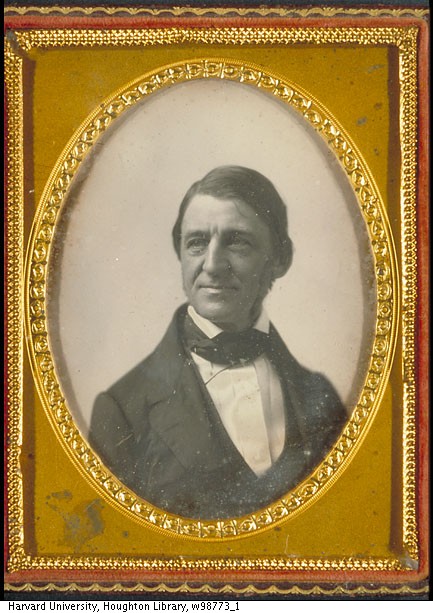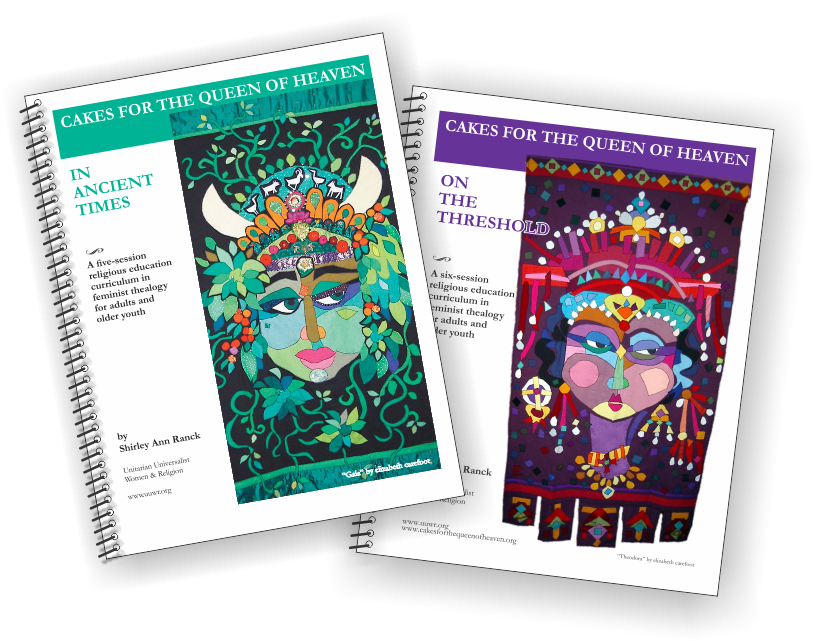
“WHY MARGARET FULLER MATTERS”
TRAVELING DISPLAY
“Why Margaret Fuller Matters” is a series of text-and-image panels designed to answer the fundamental question of why this great nineteenth-century figure remains important two centuries after her birth. This display, created during Margaret Fuller’s Bicentennial, is now available to libraries, schools, community organizations, and Unitarian Universalist congregations for the cost of shipping and an optional donation.
For those who have heard of Margaret Fuller only through her connection with her colleagues, Ralph Waldo Emerson, Bronson Alcott, Elizabeth Peabody, and other Transcendentalists, the display will allow them to honor Fuller’s own ideas and contributions. For those who have never heard of Fuller, the display will reveal how her work impacted the actors of the “second revolution” of the nineteenth century—those who dedicated themselves to applying the ideals of the American (“first”) Revolution through courageous actions grounded in revolutionary philosophy and literature.
The ten colorful 24-inch x 18-inch foam core panels that comprise “Why Margaret Fuller Matters” include: an introductory panel; brief sketches of her key colleagues; a chronological telling of her life and her views on women’s rights, education (especially female), class, slavery, American Indian rights, religion, Transcendentalism, her world view as a trans-nationalist, and her vision of a just world.
The Margaret Fuller Bicentennial Committee believes that this major figure matters because virtually every woman in the Western world who has determined her own destiny, who has forged her own spiritual life, who votes, who enjoys legal rights and full citizenship, who has sought political office, and who is free to use her intellect and talents freely without condemnation stands on Margaret Fuller’s shoulders. There are few individuals in our past to whom we can point and say, “That one person changed the course of history for the better.” Margaret Fuller was such a person.
The author and designer of the display is Bonnie Hurd Smith, who created a similar display on Emerson during his Bicentennial year in 2003. Smith, the author of numerous books on historical subjects, particularly women’s history, also is an accomplished graphic designer.
To arrange for this display at your location, please contact Gretchen Ohmann at info@uuwr.org or call (269) 369-1114. You are responsible for the cost of shipping. A suggested donation of $100 or whatever you can afford would also be appreciated but is not required. Your contributions help keep the display available.
TRAVELING DISPLAY REQUEST FORM
Display Location ___________________________________________________
Address _________________________________________________________
Website___________________________ Phone ________________________
Contact Person ___________________________________________________
Email _____________________________ Phone ________________________
Plans for display: Please describe the setting, events you envision happening in conjunction with the display, and audiences you plan to invite to participate.
Please indicate your date preference as well as the length of time you’d like to keep the display.
1st choice ________________________________________________________
2nd choice ________________________________________________________
Costs:
• Shipping costs via Federal Express Ground C.O.D. will vary depending on the distance, generally $15 – 20 for the center of the country, $40 - $50 coast to coast. Please initial your agreement to cover round trip shipping costs. ________________
• Donation: suggested amount: $100.
A donation is not required; we are grateful for whatever amount you feel you can afford
Please estimate the amount of your donation ___________________
Please indicate when you can send the donation _____________________________
__________________________________________________________________________
Please make donations payable to UU Women & Religion and send c/o Patti Clark, Treasurer, 3224 Timmons Lane #165, Houston TX 77027
Thank you!
DOWNLOAD this form in PDF format.
The author and designer of the display is Bonnie Hurd Smith, graphic designer, public historian, and author/publisher of books on Judith Sargeant Murray and other historical subjects.
Introduction
Author, editor, journalist, literary critic, educator, friend of the Transcendentalists, social commentator, women's rights advocate, and political revolutionary, Margaret Fuller left an indelible mark on Western civilization during her short forty years.
Today we consider Margaret Fuller one of the guiding lights of the first wave of feminism. She helped educate the women of her day by leading a series of Conversations in which she empowered women to read, think, and discuss important issues of the day. She influenced generations to follow through her classroom teaching, groundbreaking writings, especially her landmark book Woman in the Nineteenth Century, and through her personal example of independence and courage.
Fuller's bold public voice began to emerge in New England, but in her work for the New-York Tribune, which she transplanted to Europe, Fuller's calls for liberty and equality for all people internationally established her as a transcontinental literary ambassador.
Among her accomplishments:
- First American to write a book about equality for women
- First woman foreign correspondent and first woman war correspondent to serve under combat conditions
- First woman journalist for Horace Greeley's New-York Tribune, and first woman literary editor of a major American newspaper
- First editor of the Dial, the Transcendentalist journal, making her the first woman in America to edit an intellectual publication
- First woman literary critic who also set literary standards for American writers
- First woman to enter the Harvard College library to pursue research
Margaret Fuller matters because her all-encompassing, inspiring, and still unrealized vision--aimed at the future--challenges us to continue her work and honor her legacy.
Quote:
From Woman in the Nineteenth Century:
"If you ask me what office women may fill; I will reply--any. I do not care what case you put; let them be sea-captains if you will ... We would have every arbitrary barrier thrown down. We would have every path laid open to woman as freely as to man ... Can we wonder that many reformers think that measures are not likely to be taken in behalf of women, unless their wishes could be publicly represented by women?"
Foundations
Sarah Margaret Fuller, born on May 23, 1810, in Cambridge, Massachusetts, was the oldest child of Timothy Fuller, a Harvard-educated attorney, and Margarett Crane Fuller. With the death of an infant sister, young Margaret was an only child for several years and the center of her father's attention in particular.
Timothy Fuller planned a rigorous course of study for his daughter. "To excel in all things should be your constant aim," he told her. "Mediocrity is obscurity."
By the time Margaret was 3 1/2 years old, Timothy was teaching her how to read and write; at 4 1/2, he taught her arithmetic; just before the age of 5, she learned English and Latin grammar. Even when Timothy Fuller was elected to the U.S. Congress and spent many months in Washington, D.C., he directed Margaret's studies by mail. Margaret also read voraciously: political philosophy, great European authors and playwrights, ancient and recent history, travel, biography, and even novels -- much to her father's consternation.
When Timothy Fuller was at home, father and daughter conversed in the evenings about what she was learning. "In the process," biographer Joan von Mehren explains, "Margaret developed a well-stored mind, a remarkable facility with the spoken word and foreign languages, and the exhilarating sense that she was very alive under tension."
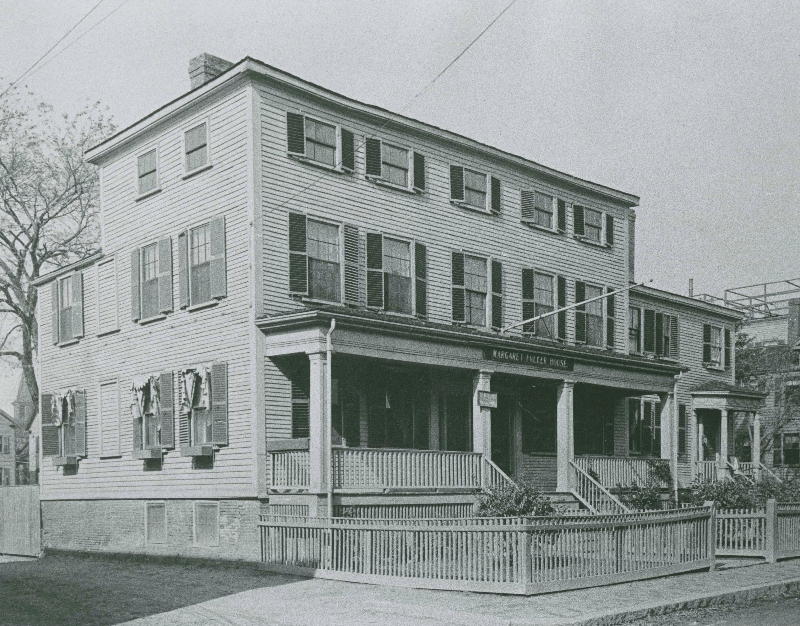
Fuller’s childhood home, 71 Cherry Street, Cambridge
(Cambridge Historical Commission)
Margaret's father stressed analytical skills, logic, and "the correct use of language, "according to von Mehren. Timothy Fuller's goal was to have his daughter develop "a secure and favored place in an ordered republican society" that was consistent with his Enlightenment values.
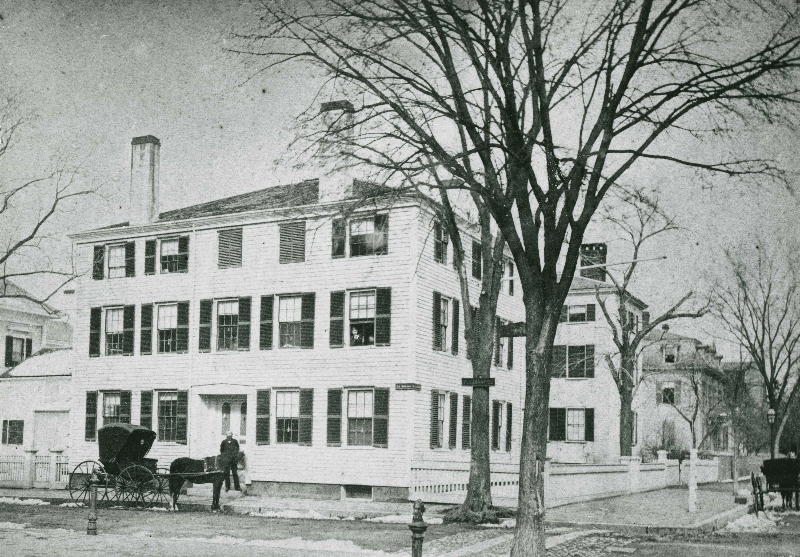
The Port School, 760 Massachusetts Avenue, Cambridge
(Cambridge Historical Commission)
At age 9, Margaret attended the Cambridge Port Private Grammar School ("The Port School") whose master was a Harvard graduate. By age 10, she had command of the standard classics in translation and was beginning to learn French. She was known as the "smart one," according to classmate Oliver Wendell Holmes. The following year, Margaret attended Dr. Park's Boston Lyceum for Young Ladies where she was ridiculed for her "country ways." She was now studying Italian, French, and geography, and attending dancing school.
Fearing their daughter's potential "unmarriageability,” the Fullers sent Margaret for a brief time to Susan Prescott's more traditional Young Ladies' Seminary in rural Groton, Massachusetts. But she soon returned to The Port School to study Greek and Latin. Eventually, at the age of 15 and with her father's assistance, Margaret Fuller created her own course of self-study, which included lessons with the author Lydia Maria Francis (later, Child).
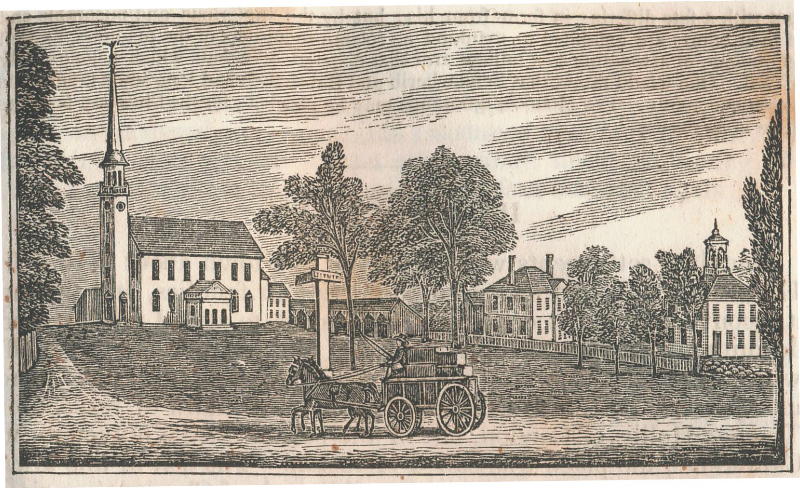
Groton, Massachusetts
Margaret became friends with a group of young Harvard students who were caught up in a heady time of intellectual, literary, and theological activity at the college. German philosophy, literature, and poetry were the "craze," and many of these young men (James Freeman Clarke, Frederic Henry Hedge, William Ellery Channing) were preparing for leadership roles in the Unitarian church. Margaret borrowed books from them, and invited them home for lively exchanges of ideas.
Like her Harvard friends, Margaret discovered the German philosopher and literary giant Johann Wolfgang von Goethe, regarded as a leading thinker by American Transcendentalists. In 1833, when the Fuller family moved to a farm in Groton, Massachusetts, Margaret felt terribly isolated from Cambridge and Boston, but she viewed her time there as her "graduate school" and began to study German in earnest.
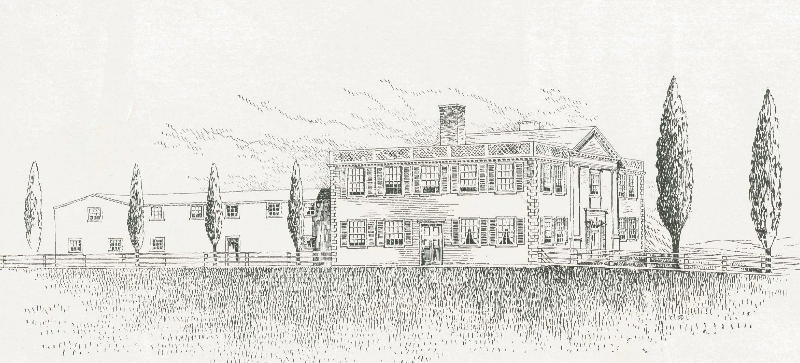
The Dana Mansion
Teaching and Self-education
Margaret Fuller's teaching career began at home, where she was responsible for the early education of her younger siblings. In Groton, she began earning money by adding neighborhood children to her home-based classroom.
While in Groton, Fuller also began writing for publications. Her first article of literary criticism (an emerging field in America), appeared in 1834 in her friend George Bancroft's Boston Daily Advertiser. She wrote literary and dramatic criticism, and translated Goethe for James Freeman Clarke's Western Messenger.
Fuller began to understand teaching young people and publishing articles as part of her larger role in life as a public educator. As Joan von Mehren explains, "Teaching was natural to her, and she would, in fact, never cease being a teacher in one guise or another."
When their father died suddenly in 1835, Margaret wrote to her brother Richard, "Nothing sustains me now but the thought that God ... must have some good for me to do." She was considered the de facto head of her family now, and their finances were meager. Fuller needed paid work, and an opportunity surfaced the following year in Concord, Massachusetts. There, during her first visit to Ralph Waldo Emerson's home, she met Bronson Alcott whose innovative Temple School in Boston would soon be without a teacher due to Elizabeth Peabody's resignation.
While Fuller waited for Alcott's job offer, she decided to move to Boston to start language and literature classes for women in German, Italian, and French. Before she left Concord, Emerson "kindly" identified "lapses" in her education. He steered Fuller toward the German and British philosophers and writers she would have studied if she had been able to attend college.
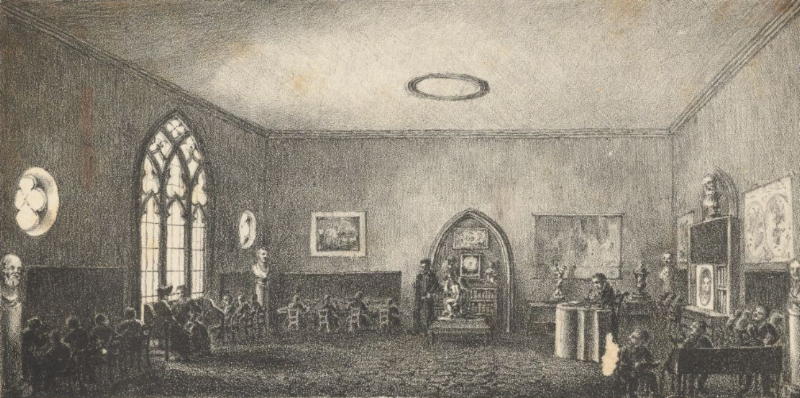
Bronson Alcott’s Temple School (Houghton Library, Harvard
University. Purchased with the Amy Lowell Fund, 1992)
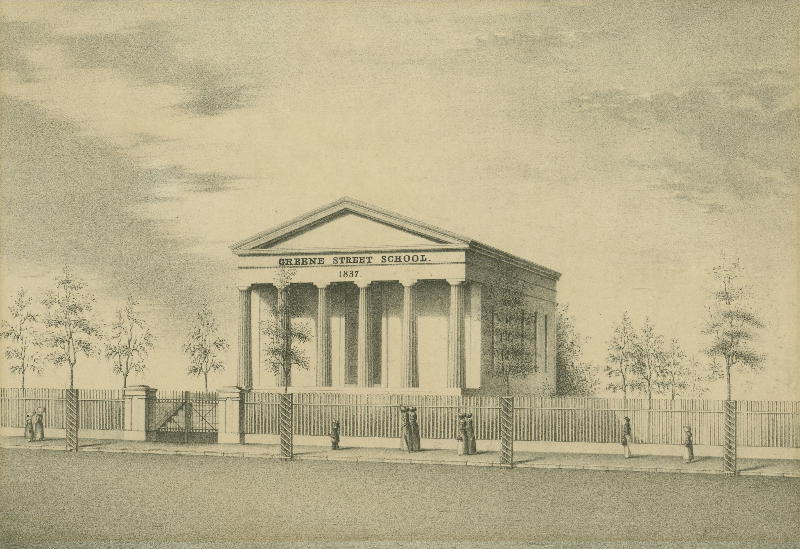
Greene Street School (Rhode Island Historical Society)
Fuller's time at the Temple School was short due to Alcott's controversial methods and the eventual closing of his school, but while there, she taught Latin, French, Italian, and kept records of the students' "conversation classes." In 1837, once again in need of work, Fuller accepted a well-paid position at Hiram Fuller's Greene Street School in Providence, Rhode Island, where she was put in charge of 60 students. She taught Latin, composition, elocution, history, natural philosophy, ethics, and the New Testament. Fuller's students described her as "strict and demanding, witty and authoritarian, at times unreasonable but always formidable, challenging, and impressive." Students were drawn to the school because of Fuller's reputation.
In the evenings, Fuller taught German language classes for women and men and worked on a biography of Goethe. She joined the intellectual Coliseum Club where she delivered her first public speech on "the sorry relation of women to society."
Earlier, during a visit to Concord, Fuller participated in gatherings of the "Transcendentalist Club"--the first time women were allowed as members in a "major male intellectual society," according to biographer Charles Capper. Before leaving Providence due to her failing health, Fuller observed, "I am not without my dreams and hopes as to the education of women."
Returning to Boston, Fuller made plans to hold what she called "Conversations" for women at Elizabeth Peabody's bookstore on West Street. Her initial purpose was not at all political. Instead, Fuller was interested in exploring two fundamental questions: What were we born to do? How shall we do it? These were questions "which so few ever propose to themselves 'til their best years are gone by." At the very least, she hoped to provide "a point of union to well-educated and thinking women" where they could satisfy their "wish for some such means of stimulus and cheer, and ... for a place where they could state their doubts and difficulties with hope of gaining aid from the experience or aspirations of others."
Margaret Fuller's lucrative Conversations continued for five years and attracted approximately 200 students. Among them were some of the most prominent women intellects, authors, and reformers in New England including Julia Ward Howe, Lydia Maria Child, and Ednah Dow Cheney. Eventually, given the heightened political activity in Boston on the subjects of slavery and women's rights, Fuller's Conversations took a decidedly political turn.
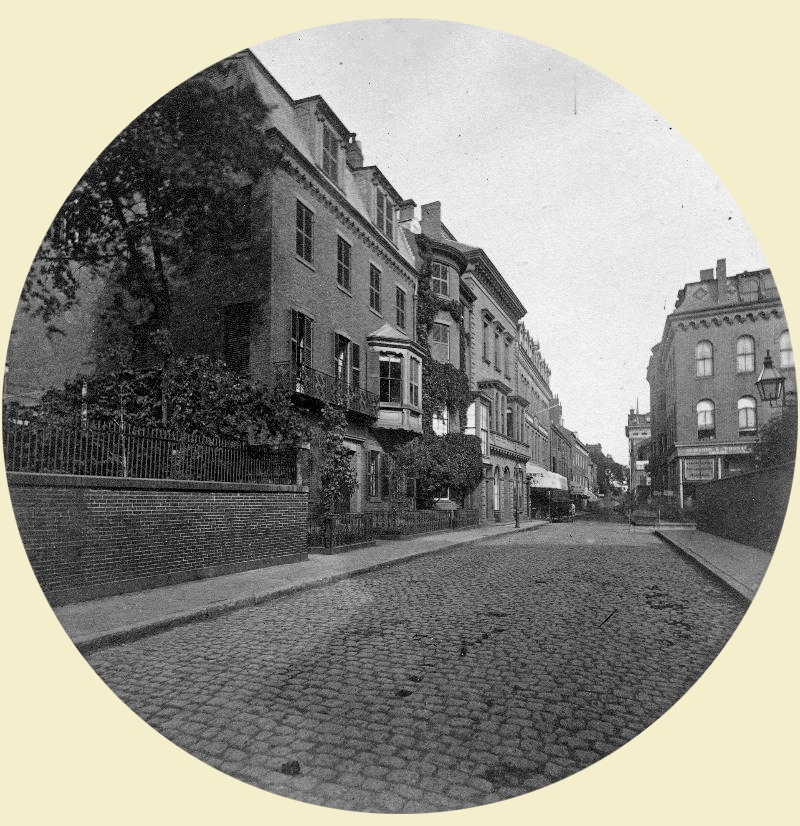
13-15 West Street, Boston (left) (The Bostonian Society)
Emerging Voice
In 1840, when Margaret Fuller agreed to serve as the first editor of the Dial at Ralph Waldo Emerson's request, she propelled herself even further into the public eye. While Fuller shunned the "Transcendentalist" label for herself, the Dial provided a vehicle for Transcendentalists to explain and defend themselves from criticism and misinterpretation. The Dial served as a forum for new authors and new ideas. Fuller saw the publication as “a perfectly free organ ... for the expression of individual thought and character, [one that would] not aim at leading public opinion, but at stimulating each man to think for himself."
Fuller solicited work from such writers (and friends) as Bronson Alcott, Frederic Henry Hedge, Caroline Sturgis, Ellery Channing, Henry David Thoreau, Theodore Parker, Elizabeth Peabody, George and Sophia Ripley, and, of course, Emerson. She also provided her own articles on literary and cultural criticism and biography. Fuller's 1841 article on Goethe brought her acclaim as a leader in American cultural thought, and perhaps prompted her first visit to Brook Farm, the Utopian Transcendentalist community in West Roxbury, Massachusetts, founded by the Ripleys.
|
Ralph Waldo Emerson |
Debut issue of the Dial, July 1, 1840 (Andover-Harvard Theological Library) |
One of the key areas where Transcendentalists and other reformers clashed was on the subject of social and political change. Should reform happen within the individual or by tackling institutions and taking radical action? At the time, Fuller shied away from joining any particular group, preferring to examine many sides. But her two-year stint as editor of the Dial set her on a path toward radicalism and shaping public opinion.
Due to the financial instability of the publication Fuller never received her promised payment for being editor, so in 1842 she resigned. Emerson told her, "You have played martyr a little too long alone: let there be rotation in martyrdom!" and she gratefully turned over the editorship of the Dial to him. Fuller spent time that summer traveling with friends in New England. In Boston, she continued her language classes and Conversations, which became increasingly political.
In an 1843 edition of the Dial, Emerson published the essay that would initiate the next phase of Fuller's public life. In "The Great Lawsuit: Man vs. Men and Woman vs. Women," she held up the egalitarian ideals of the American Revolution. Fuller pointed out that while these ideals did not yet apply to women, African Americans, and Native Americans, Americans had a "special mission" to strive toward a just social system -- and to assist others in the world who were initiating their own revolutions. Human freedom was a right, she asserted.
Fuller also threw out the ideology of "separate spheres" for women and men, instead addressing the conflicts between what was "male" and what was “female" within each person. She looked at gender roles in male and female friendships, and the laws and customs associated with marriage (subjects she also examined in her personal life as a single woman with male friends and married friends). She boldly exposed patriarchy and its effects.
Fuller's groundbreaking essay caught the attention of another outspoken literary reformer -- Horace Greeley, the publisher of the progressive New-York Tribune. He printed an excerpt of "The Great Lawsuit" in his newspaper in 1843.
Meanwhile, Fuller traveled to what was then considered the "western frontier" (Illinois and Wisconsin) with James Freeman Clarke, his sister, Sarah, an artist, and their mother, Rebecca, where she wanted to experience the American wilderness. She hoped to find instances of socially progressive communities far away from the East. Instead, what caught her attention were the consequences of the displacement of native peoples and the struggles of the settlers, especially the women, to survive difficult conditions.
Fuller saw the disparity between the promise of America and the reality of America, and the result was her 1844 book Summer on the Lakes, in 1843 -- an honest, first-hand account of conditions out west and a condemnation of U.S. policy. Biographer Charles Capper explains that she "[put] the region on the national literary and intellectual map and attract[ed] a national audience."
Summer on the Lakes was the first time Fuller used her own name in her work; the research she completed at Harvard made her the first woman to use Harvard's library (in Gore Hall).
Once again, Margaret's boldness caught the attention of Horace Greeley. He offered her a job in New York.
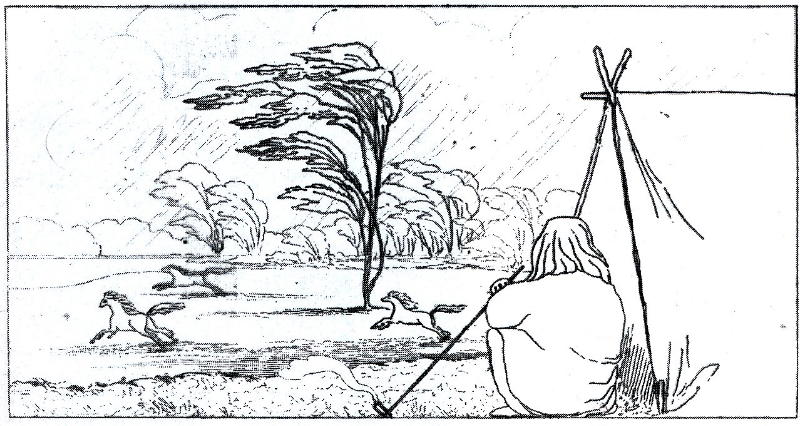
One of Sarah Clarke’s drawings that appears in Summer on the Lakes, in 1843
Public Voice

“In cities and small towns throughout New England, New York, the Great Lakes, and the Ohio Valley, farmers, mechanics, and small merchants read the weekly aloud to their families, loaned it to neighbors, and organized ‘Tribune Clubs’ to discuss its latest news and pronouncement on national and international affairs. ‘The Tribune comes next to the Bible all through the West,’ its roving reporter Bayard Taylor would soon brag to his boss, and considering the multiple times each copy was read and its articles reprinted in other newspapers, Taylor’s boast was almost an understatement.” —Charles Capper
Horace Greeley put Margaret Fuller's essays on Page One of his reform-minded newspaper, the New-York Tribune. She signed them with the symbol of a star, or an asterisk. Greeley paid Fuller the same salary as a man's, gave her a place to live when she first arrived, and encouraged her to write with "force." Fuller thus became the first woman in America to head the literary department of a major newspaper.
Fuller reviewed books (American and foreign), periodicals, musical events, concerts, lectures, and art exhibits. She visited and wrote about New York's "benevolent" institutions--prisons, hospitals, almshouses, insane asylums, homes for the blind and deaf. Now in a position to influence popular culture and social policy through first-hand observations, her urge to tell the truth and exceptional writing talent brought her fully into the public arena.
Greeley saw her as "a philanthropist, preeminently a critic, a relentless destroyer of shams and outward traditions."
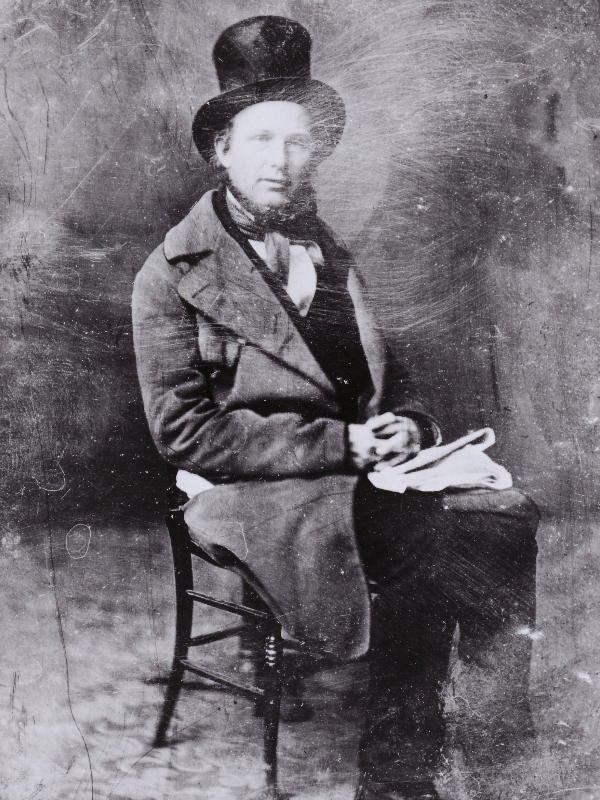 “Texas annexed, and more annexations in store;
“Texas annexed, and more annexations in store;
Slavery perpetuated, as the most striking new feature
of these movements. Such are the fruits of American
love of liberty! Mormons murdered and driven out, as
an expression of American freedom of conscience.
Cassius Clay’s paper expelled from Kentucky; that is
American freedom of the press. And all these deeds
defended on the true Russian grounds: ‘We (the stronger)
know what you (the weaker) ought to do and be, and it
shall be so.’” —Margaret Fuller, 1845
Fuller's social commentary included condemnations of the approaching war with Mexico, the annexation of Texas, and the expansion of slavery. As historians Judith Mattson Bean and Joel Myerson explain, "She realizes that a war would drastically reconfigure the nation's population and landscape, leaving a legacy of dispossession and ethnic conflict. Fuller's essays actively resist American imperialism with attempts to subvert racist American expansionist rhetoric ... [her] participation in this debate was significant for another reason: the war with Mexico played a critical role in her disillusionment with America ... she began to equate U.S. national policy with European despotism and imperialism."
America's national identity was in crisis in the 1840s. There were questions about American literary independence from Europe and the United States' responsibility to foreign revolutionaries. Bean and Myerson point out:
"In reviewing contemporary American literature, Fuller practices a democratic criticism that challenges writers to uphold ideals of liberty and equality. Her political essays also argue that America's principles of liberty and equality are endangered by American materialism, greed, and the desire for continental domination. She directs attention to the relation of dominant American society to the other, contending that American society is founded upon tolerance and upon recognition of universal human rights rather than domination by force."
In 1846, learning that her friends Marcus and Rebecca Spring would be traveling to Europe to observe new and effective social institutions, Fuller and Horace Greeley decided she should go as well and send dispatches to the Tribune from the cities, towns, and countries she visited.
Before she left New York, Margaret wrote to her brother Richard, "I have now a position when if I can devot[e] myself entirely to use its occasions, a noble career is yet before me ... I want that my friends should wish me now to act in my public career."
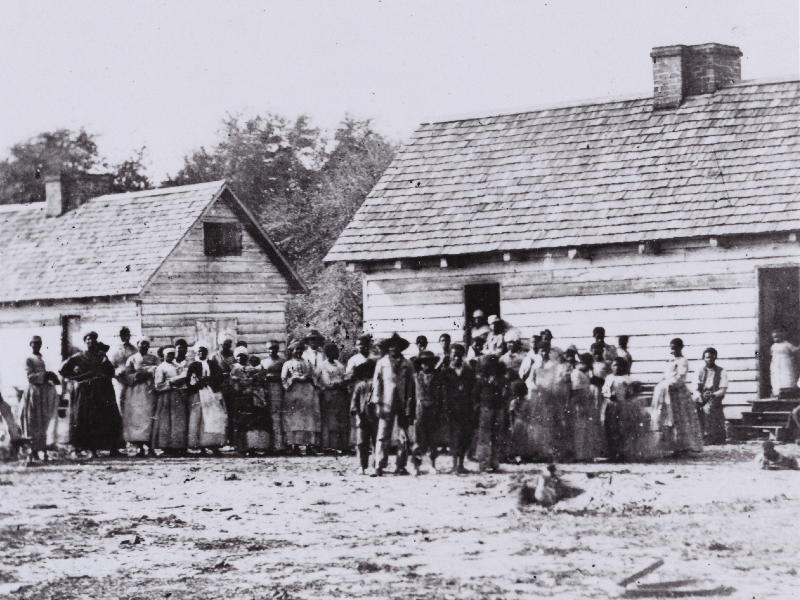
Enslaved African Americans on Smith’s Plantation, Beaufort, South Carolina
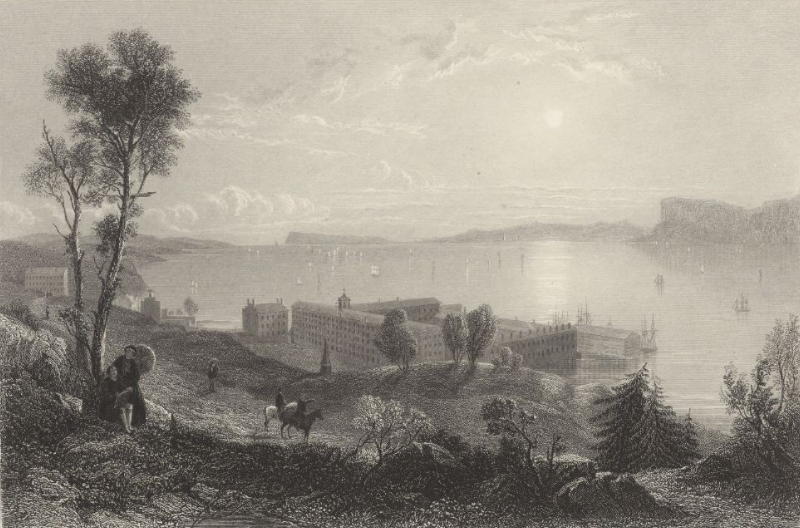
Sing Sing Prison, New York (Houghton Library, Harvard University.
Purchased with the William Inglis Morse Fund, 1943)
Reformer
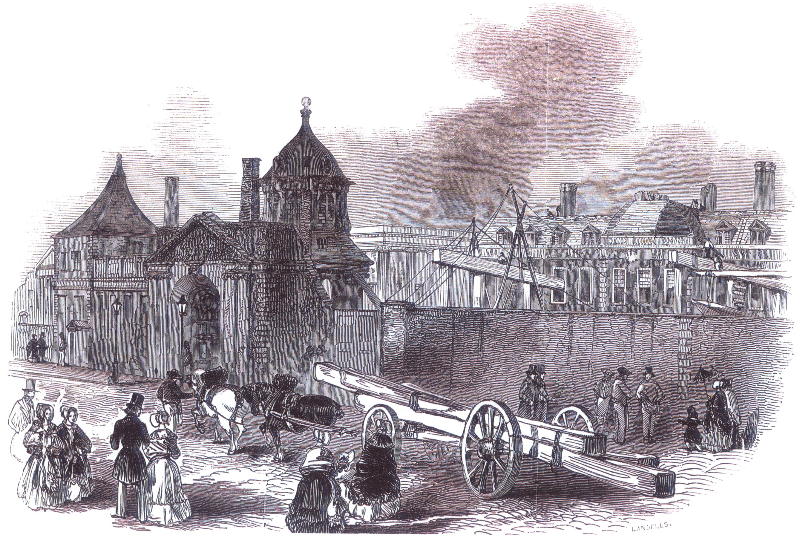
The British Museum under construction, 1845 (Illustrated London News)
In Europe, where industrialization was more advanced than in the U.S., Fuller hoped to find successful models of communities and institutions to prevent the expansion of poverty back home. During this time of steamships, railroads, telegraphs, and booming emigration to American cities, Judith Mattson Bean and Joel Myerson explain, “She envisions American culture as receiving not only people but seeds of thought and expression from other nations.” These “thoughts” could be cultural as well as social and political.
In Liverpool and Manchester, England, Fuller went to Mechanics Institutes where anyone (male or female) with 5 shillings could attend lectures, take courses, or see art exhibitions. In London, she reported on cultural and literary goings-on. In Paris, when she visited homes, hospitals, and day care centers for the sick children of the poor, she observed evening schools where boys were taught a trade. In her dispatches to the New-York Tribune, she recommended that America immediately adopt such measures.
But it was the urban poverty of the slums that affected Fuller most of all, and the clear need for reform. In a dispatch from France she wrote, “The need of some radical measures of reform is not less strongly felt in France than elsewhere, and the time will come before long when such will be imperatively demanded.”
She also wrote, “To themselves be woe, who have eyes and see not, ears and hear not, the convulsions and sobs of injured Humanity.”
Two questions plagued Fuller’s mind: What was her role in what she was witnessing? What was America’s role?
As Joan von Mehren points out, after visiting Paris, “Every one of her columns now made some plea on behalf of its ‘injured Humanity.’” While the initial purpose of Fuller’s journey to Europe was “to seek useful ideas to transplant to the new world,” she was transformed by her experience into “a radical vocation to communicate the monstrous suffering and human waste of the historical movement.”
If there was any doubt in Fuller’s mind about her stature as an international voice, there was no doubt in the minds of her new European friends. Fuller’s reputation preceded her. They seemed to know she was destined to bridge the two continents and promote the reforms that were in their mutual interest. They embraced her.
In England, she renewed her acquaintance with social commentator Harriet Martineau, met the poet William Wordsworth, and the co-editors of the People’s Journal Mary and William Howitt (whose modern marriage she had described in Woman in the Nineteenth Century). She also met Giuseppe Mazzini, the legendary exiled Italian revolutionary about whom Fuller had written for the Tribune. She was drawn to his cause and became his confidante and secret messenger.
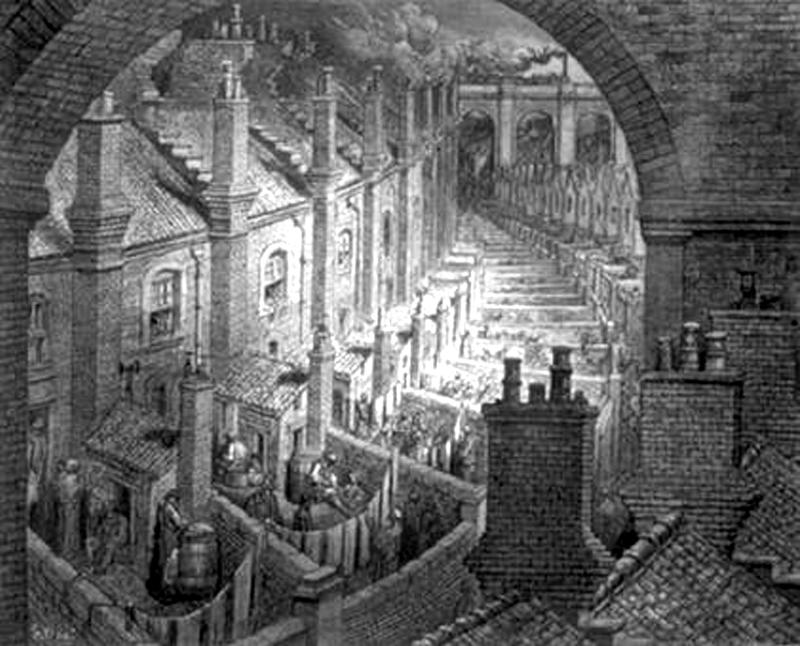
London slums, 1856
In Paris, Fuller met George Sand and Pierre Leroux, who invited her to publish work in their periodical La Revue Indépendante. She was introduced to the exiled Polish revolutionary and poet Adam Mickiewicz, who became a kind of spiritual guide.
Fuller was in her element, filled with a sense of purpose and armed with the skills and mechanism (the Tribune) to make a difference. But the best was yet to come—Italy.
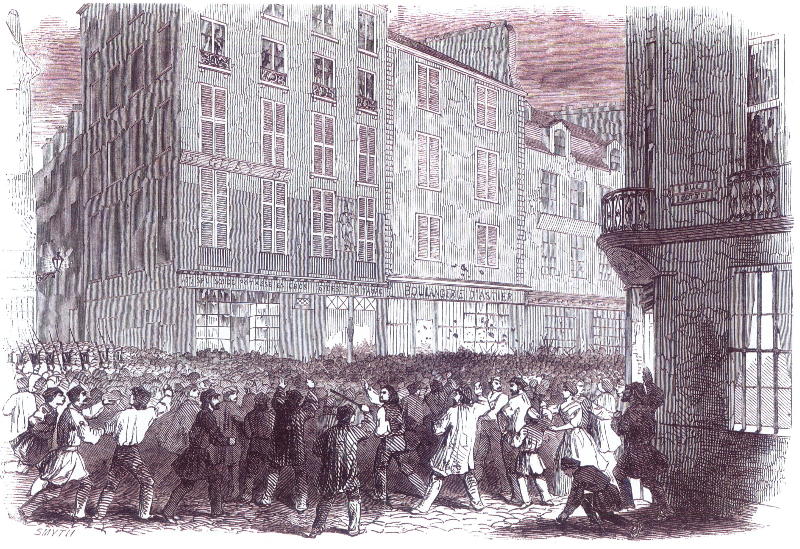
Bread Riot in the Rue du Fauborg St. Antoine, Paris, 1846 (Illustrated London News)

The Pont Neuf, Paris, 1845
Revolutionary
Margaret Fuller arrived in Italy in March 1847, carrying secret letters from the Italian revolutionary Giuseppe Mazzini and knowing she was heading into a turbulent political situation. What Mazzini and his supporters hoped to forge was a united Italian Republic starting with Rome, where the new Pope, Pius IX, seemed open to reform. The revolutionaries wanted to limit the Pope’s power to spiritual matters; secular matters, like governance, should be left to democratically elected officials. With Rome as the head of a new republic, the rest of the independent states comprising Italy could join and form one democratic nation. Austrian and French forces, in particular, had other ideas. So did the Pope, whom Fuller took on in one of her more gutsy dispatches to the New-York Tribune, her employer.
Among Mazzini’s supporters was the Marchese Giovanni Angelo Ossoli, the youngest son of an aristocratic Catholic family with ties to the Pope. Fuller fell in love with him, and gave birth to their child, Angelo Eugene Phillip Ossoli (“Nino”) in 1848 in Reiti, where she had temporarily relocated for their safety. She returned to Rome as soon as she found caretakers for Nino, and resumed her work as the first woman foreign correspondent for a major newspaper to serve in wartime.
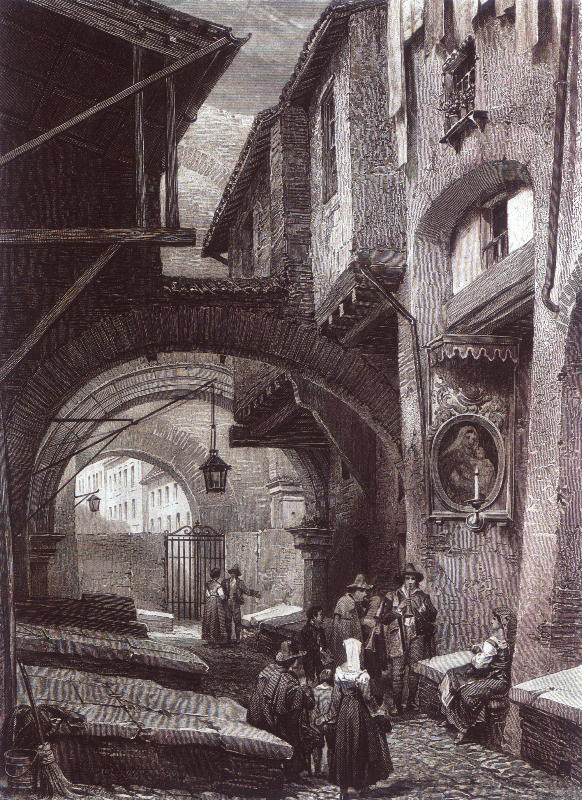 “[K]ings may find their thrones rather crumbling than tumbling;
“[K]ings may find their thrones rather crumbling than tumbling;
the priests may see the consecration wafer turn into bread to
sustain the perishing millions even in their astonished hands.
God grant it. Here lie my hopes now. I believed before I came
to Europe in what is called Socialism, as the inevitable sequence
to the tendencies and wants of the era, but I did not think these
vast changes in modes of government, education and daily life,
would be effected as rapidly as I now think they will, because they
must. The world can no longer stand without them.”
—Margaret Fuller, 1850
Fuller observed the Roman Revolution first-hand, managed a hospital, assisted her husband on the front lines, and began to write a modern history of the movement. In one of her last dispatches from Rome she wrote, “The New Era is no longer an embryo; it is born; it begins to walk—this very year sees its first giant steps, and can no longer mistake its features. Men have long been talking of a transition state—it is over—the power of positive, determinate efforts is begun.” However, Fuller did not believe republican forms of government would take hold in Europe until the next century, and she was right.
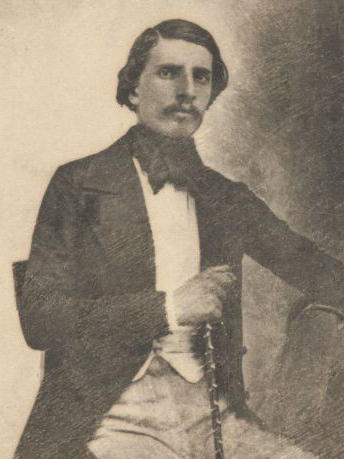 “Giovanni Angelo Ossoli
“Giovanni Angelo Ossoli
(Houghton Library,
Harvard University.
Bequest of Edith D. Fuller)
I have wished to be natural and true, but the world was not in harmony with me—nothing came right for me. I think the spirit that governs the Universe must have in reserve for me a sphere where I can develop more freely, and be happier.” —Margaret Fuller
The Ossolis (Fuller began to refer to herself as the Countess Ossoli and assured her friends they had married) escaped from Rome in 1850 as the revolution fell apart. Although she had a nightmare about the voyage and wrote to friends that she had a terrible sense of foreboding, the family eventually sailed for New York where Fuller knew she could find a publisher for her history.
It was an awful journey. The captain died of cholera on the way which Nino, her baby, also contracted. Before the steamer Elizabeth could reach its destination, and under the direction of a less experienced captain, a storm crossed its path, the ship ran aground, and eventually capsized just off Fire Island, New York. Some passengers were rescued, while others waited for help. Onlookers looted the items that washed ashore.
All three Ossolis perished at sea, along with Margaret’s manuscript of the Roman Revolution. Only Nino’s body was recovered, and he was buried in the Fuller family plot at Mount Auburn Cemetery in Cambridge, Massachusetts, where a cenotaph in Margaret Fuller Ossoli’s memory now stands.
In a plea to her American audience from Rome, Fuller had written, “I pray you do something; let [the revolution] not end in a mere cry of sentiment … Do you owe no tithe to heaven for the privileges it has showered on you, for whose achievements so many here suffer and perish daily? Deserve to retain them by helping your fellow-men to acquire them … Friends, countrymen, and lovers of virtue, lovers of freedom, lovers of truth!—be on the alert; rest not supine in your easier lives, but remember
‘Mankind is one And beats with one great heart.’”
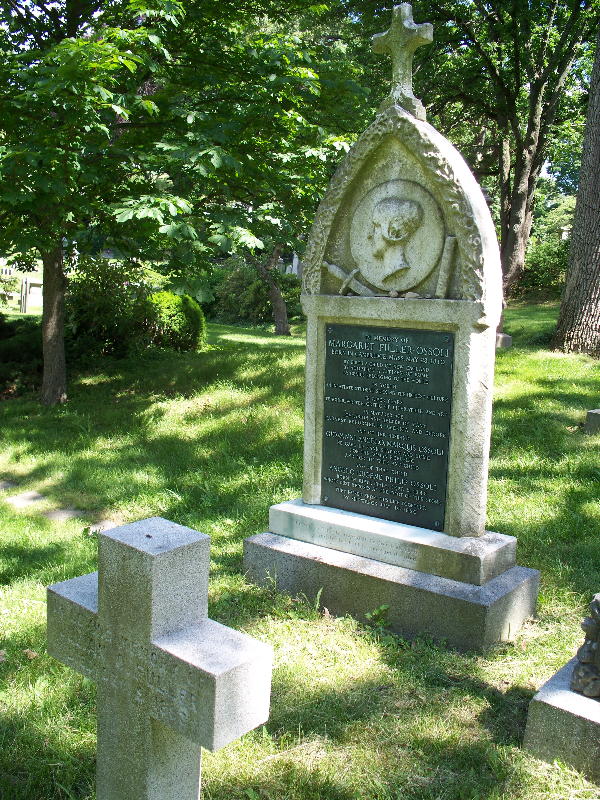
Fuller Ossoli, Mount
Auburn Cemetery,
Cambridge,
Massachusetts.
The inscription:
“Born a child of
New England,
By adoption a
citizen of Rome,
By genius belonging
to the World”
Tributes
"Higher natures like hers, living for higher aims, have a more evident Providence managing their destiny, & it was manifest that she was not to come back to struggle against poverty, misrepresentation, & perhaps alienated friendships and chilled affections. There seemed no position for her here, & her life was complete, so far as experience & development went. That she shd. have accomplished so little for the public in proportion to her genius & attainments is to us a loss -- but her own aim was rather development than manifestation, & that first aim she perfectly fulfilled. Her life will seem to us now complete & round."
--James Freeman Clarke
"To the last her country proves inhospitable to her; brave, eloquent, subtle, accomplished, devoted, constant soul! If nature availed in America to give birth to many such as she, freedom & honour & letters & art too were safe in this new world."
--Ralph Waldo Emerson
"She is full of all nobleness, and with the generosity native to her mind & character, appears to me an exotic in New England, a foreigner from some more sultry & expansive climate. She is, I suppose, the earliest reader & lover of Goethe, in this country, and nobody here knows him so well. Her love too of whatever is good in French & especially in Italian genius, give her the best title to travel. In short, she is our citizen of the world by quite special diploma."
--Thomas Carlyle
"America has produced no woman who in mental endowments and acquirements has surpassed Margaret Fuller."
--Horace Greeley
"The Conversations were a 'vindication of woman's right to think.'"
--Elizabeth Cady Stanton
"How characteristic are all the things told of Margaret on board, giving her only life-preserver to a sailor to seek for help, when a less sanguine or more selfish person would not have done [so] -- her refusing to part with her child when she could not have saved him...; her securing the money about her showed how much she felt the need of it -- One who had always been taken care of would not have done so when lives were in danger."
--Caroline Sturgis Tappan
"There was ... a fate in her, and was in the struggle against this, that she wrought her greatest victories. I think her courage surpassed by no woman I have met. It made her life one of the revolutions, and brought her to the tragic end."
--Bronson Alcott
"To her, I, at least, had hoped to confide the leadership of this movement. It can never be known if she would have accepted it...; she was, and still is a leader of thought; a position far more desirable than a leader of numbers."
--Paulina Wright Davis, president, Woman's Rights Convention, Worcester, Massachusetts, 1850; the convention observed a moment of silence in her memory before proceeding
"She was not framed by nature for a mystic, a dreamer, or a bookworm ... but a career of mingled thought and action, such as she finally found."
--Thomas Wentworth Higginson
"For as long as she lived, and afterward too, almost everyone who knew Fuller well groped for words when they tried to describe her; nearly all of them were compelled, sooner or later, to use the word 'force.'"
--Joan von Mehren, biographer
Body of Work
"She gave a national dimension to the role of the literary critic, bringing to it a political and social conscience that has been the hallmark of its best practitioners ever since."
--Joan von Mehren
"Responding to literature and the social problems of the 1840s, she gained the power of self-expression and chose positions that made her an articulate critic of American and European culture."
--Judith Mattson Bean and Joel Myserson
"Most distinctive was her voice: politically savvy, culturally alert, and electrically charged by a vibrant intellectual personality grappling with one of her deepest conundrums--her identity as an American cosmopolitan liberal--resounding off the screen of the greatest European political cataclysm of the nineteenth century."
--Charles Capper
Articles
 Literary criticism
Literary criticism- American Monthly Magazine
- Boston Daily Advertiser and Patriot
- Boston Quarterly Review
- The Dial
- La Revue Indépendante
- Present, the Spirit of the Age
- New-York Tribune
- Western Messenger
Cultural commentary
- The Dial
- New-York Tribune
Biographical sketches
- The Dial
- New-York Tribune
Social commentary
- The Dial
- New-York Tribune
- United States Magazine and Democratic Review
Translations
- Published privately by Elizabeth Peabody
- Western Messenger
Books
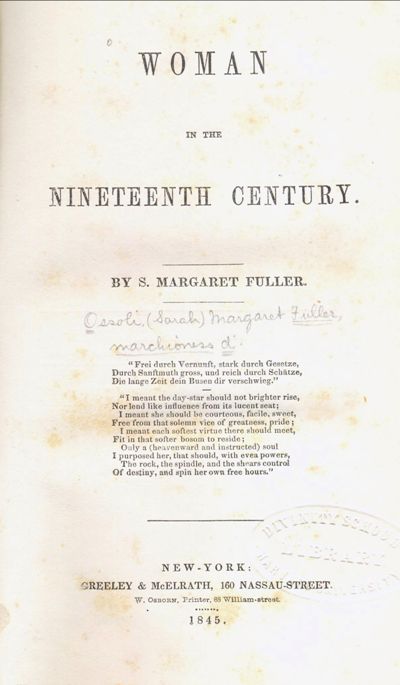 "Conversations with Goethe in the Last Years of His Life," (published by Hilliard, Gray and Company, Boston, as part of George Ripley's Specimens of Foreign Standard Literature series, 1839)
"Conversations with Goethe in the Last Years of His Life," (published by Hilliard, Gray and Company, Boston, as part of George Ripley's Specimens of Foreign Standard Literature series, 1839)
Summer on the Lakes, in 1843 (Little and Brown, Boston, 1844)
Woman in the Nineteenth Century (Greeley and McElrath, 1845)
Papers on Literature and Art (Wiley and Putnam, New York, 1846)
A Modern History of the Roman Republic (actual title unknown, manuscript lost at sea)
Published Posthumously
Memoirs of Margaret Fuller Ossoli (prepared by William Henry Channing, James Freeman Clarke, Ralph Waldo Emerson, published in 1852 by Phillips, Sampson and Company in Boston; the best selling biography of the 1850s; by the end of the century, there were 13 editions including one in German)
Woman in the Nineteenth Century and Kindred Papers (prepared by Arthur Fuller, published in 1855 by John P. Jewitt, Boston)
At Home and Abroad
(a compilation of Tribune articles and letters written from abroad; compiled by Arthur Fuller, published in 1856 by Crosby, Nichols, and Company, Boston)
Life Within and Without
(Dial and Tribune articles written in New York; compiled by Arthur Fuller, published in 1860 by Brown, Taggard, and Chase, Boston)
Fuller quote:
"I felt a delightful glow as if I had put a good deal of my true life in it, as if, suppose I went away now, the measure of my foot-print would be left on the earth."
--Margaret Fuller, on completing Woman in the Nineteenth Century
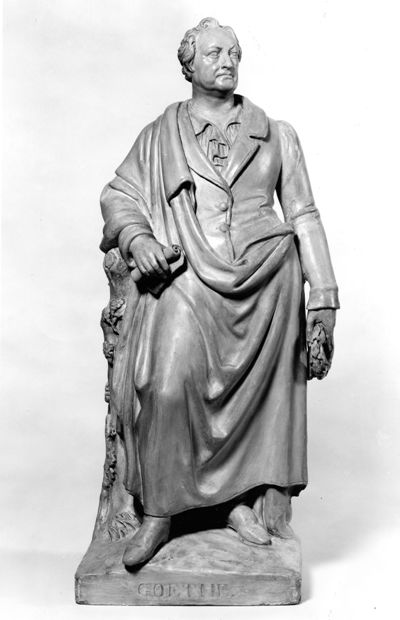 Johann Wolfgang von
Johann Wolfgang von
Goethe, whose influence
on Fuller and the American
Transcendentalists was
profound; Fuller’s biography
of him brought her acclaim
and stature (National
Park Service, Longfellow
National Historic Site )
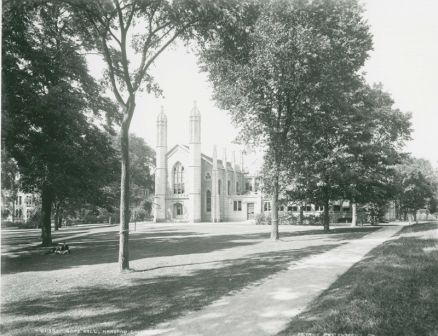
Gore Hall, Harvard College Library; Margaret Fuller was the
first woman allowed to use Harvard’s library for her own research
(Cambridge Historical Commission)
Friends
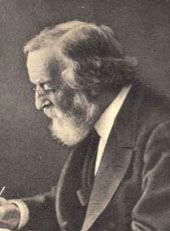 James Freeman Clarke
James Freeman Clarke
Fuller met Clarke while he was a student at Harvard studying for the Unitarian ministry. He became part of the circle she gathered around her as a young woman in Cambridge. Clarke published some of Fuller’s earliest work in the Western Messenger, a periodical he started in 1835. (Photo: Andover-Harvard Theological Library)
William Henry Channing
The nephew of William Ellery Channing, William Henry was a Harvard-trained Transcendentalist Unitarian minister. He was a prolific writer for the Dial, and the editor of the socialist periodical Present to which Fuller contributed. Channing was an Associationist, a movement that married socialism with Christianity.
Lydia Maria Francis Child
One of Boston’s foremost abolitionists and Unitarians, Child was the author of America’s first anti-slavery book. She tutored young Margaret at the Francis home in Watertown, Massachusetts, and later continued their friendship in Boston and New York where Child edited the National Anti-Slavery Standard.
Ralph Waldo Emerson
Considered the leader of the American Transcendentalist movement, Emerson was an author, philosopher, lecturer, former Unitarian minister, and founder of the Dial, which he asked Fuller to edit. Fuller first met Emerson at his home in Concord, Massachusetts, where many Transcendentalists gathered at the informal “Concord University.” Their relationship is the subject of much study. He was an early mentor and friend, but Fuller exerted her independence of thought.
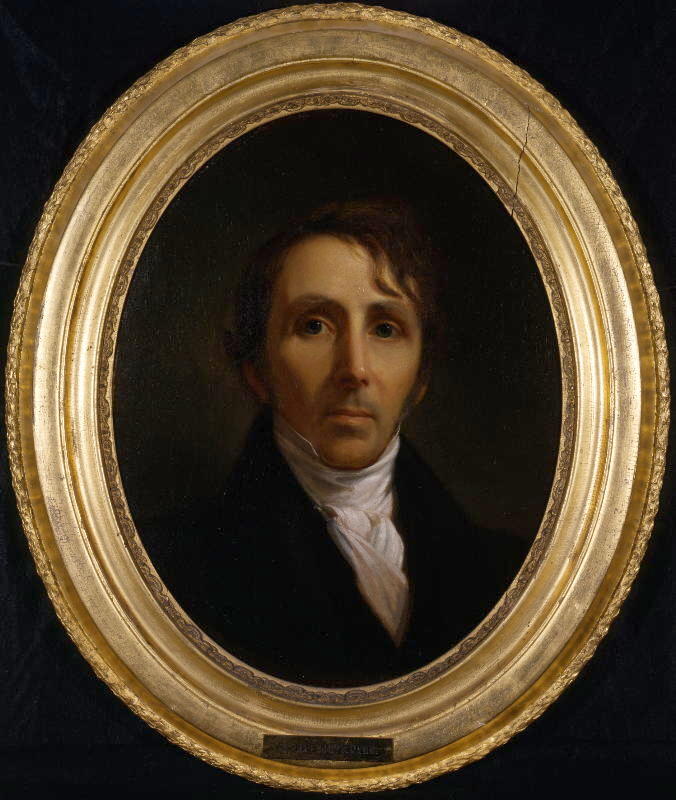 William Ellery Channing
William Ellery Channing
As the leading Unitarian minister in Boston and the nation, Channing was a central figure in the lives of Fuller and her Transcendentalist friends. As the historian Frank Carpenter explains, “Channing fervently believed God had made human nature, with its capacity for moral choice and ever increasing understanding, akin to the divine. He confidently preached the possibility of unending moral and spiritual progress for all who would shape their lives in accordance with its demands.” As a young woman, Fuller worked for Channing as a reader and translator and she attended his Federal Street Church. Channing’s nephew, Ellery, married Fuller’s sister Ellen. (Photo: Imaging Department © President and Fellows of Harvard College)
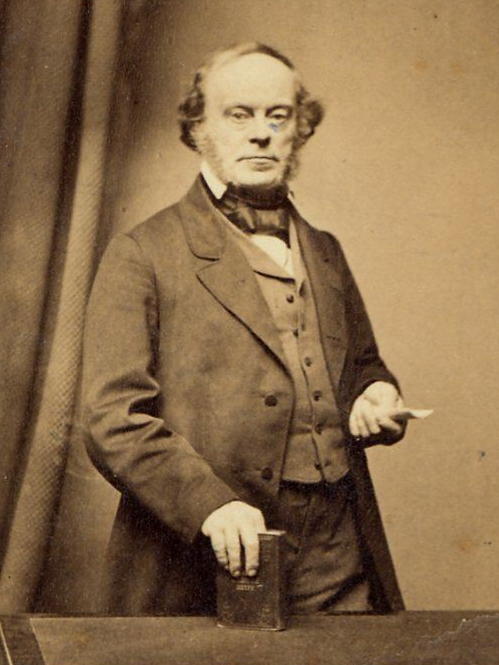 Frederic Henry Hedge
Frederic Henry Hedge
Hedge and Fuller became friends while he was studying for the Unitarian ministry at Harvard. Hedge was also an author, and part of the Emerson group in Concord where he founded what would become the Transcendentalist Club. Fuller was invited to join the club, which was the first time women were allowed as members of a leading male intellectual society. Hedge served on the faculty at Harvard and edited The Christian Examiner. (Photo: Andover-Harvard Theological Library)
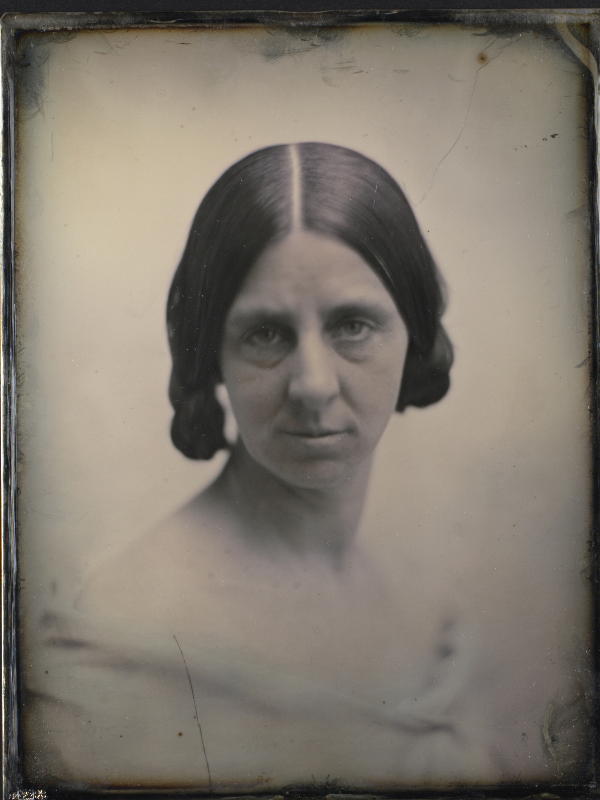 Caroline Sturgis Tappan
Caroline Sturgis Tappan
Transcendentalist, poet, and children’s author, Caroline Sturgis was one of Fuller’s closest friends and part of the Concord group. During Fuller’s period of homelessness, they traveled together. Tappan attended Fuller’s Conversations, and contributed to the Dial. (Photo: George Eastman House, International Museum of Photography and Film)
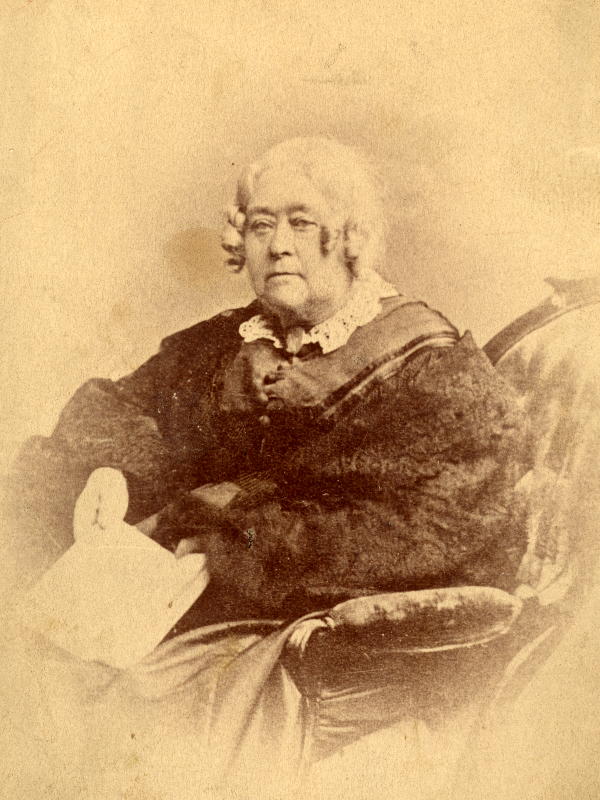 Elizabeth Peabody
Elizabeth Peabody
Peabody’s bookstore on West Street in Boston was the site of Fuller’s Conversations, which Peabody attended along with her sisters Mary and Sophia. Peabody taught at Bronson Alcott’s Temple School and founded the kindergarten movement in America. She was an author and the first woman publisher in Boston. (Photo: Concord Free Public Library)
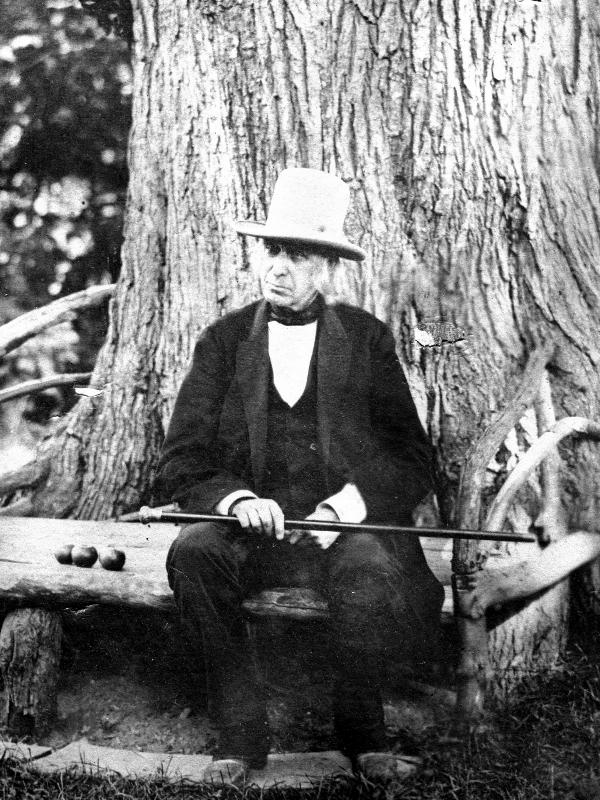 Bronson Alcott
Bronson Alcott
Fuller met the educator, philosopher, and Transcendentalist in Concord in 1836 and moved to Boston to teach at his controversial Temple School. Alcott’s discussions of sexually explicit subjects, reinterpretations of the Gospel, and acceptance of an African American student caused the school to close in 1837. Alcott later helped found the failed utopian community Fruitlands in Harvard, Massachusetts. (Photo: Concord Free Public Library)
Hiram Fuller
Hiram Fuller (no relation) hired Fuller for an impressive salary to teach at his Greene Street School in Providence, Rhode Island, in 1837. There, with her students, Fuller really blossomed as a teacher and first examined female culture. She gave her first public speech on the subject at the intellectual Coliseum Club. Hiram Fuller was a follower of Bronson Alcott, applying many of Alcott’s child-centered methods to his own school.
Horace Greeley
Greeley noticed Fuller’s bold writing in the Dial and hired her for his reformist Whig newspaper, the New-York Tribune, making Fuller the first woman to head the literary department of a major American newspaper. Fuller established herself as a leading public voice for social and political reform. When Greeley published her writings from Europe, Fuller became the first woman correspondent and the first woman journalist to serve during wartime for a major American newspaper. Greeley published Fuller’s most famous work, Woman in the Nineteenth Century.
Harriet Martineau
Fuller first met Martineau in Cambridge, Massachusetts, while the celebrated and outspoken British journalist, philosopher, and social commentator was touring the United States. While Martineau was somewhat critical of Fuller’s book Woman in the Nineteenth Century, and Fuller took issue with Martineau’s book Society in America, the two women resumed their friendship while Fuller was in England.
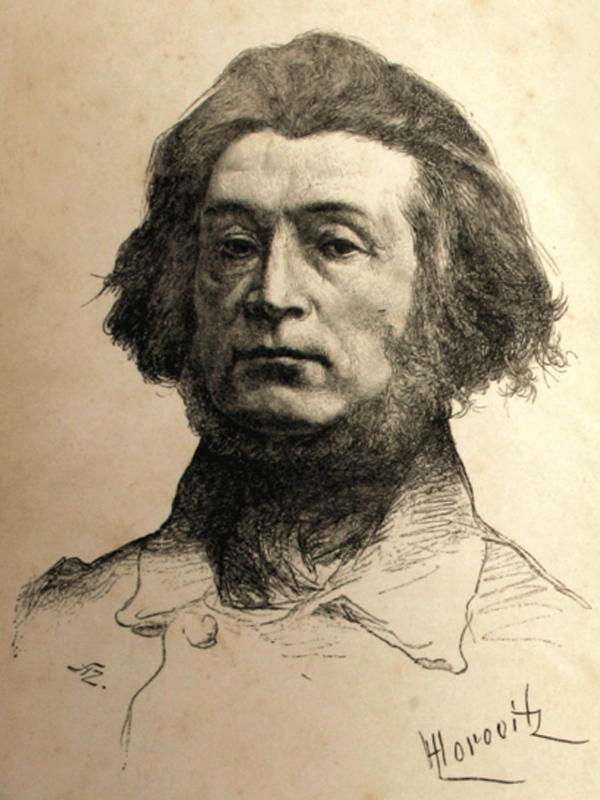 Adam Mickiewicz
Adam Mickiewicz
Poet, preacher, and exiled Polish revolutionary, Fuller met Mickiewicz in England and he became a kind of spiritual guide to her. He encouraged her to lead a more balanced life, professionally and spiritually. According to Joan von Mehren, Mickiewicz told her that in Europe “Her soul would find its sustenance in the Old World, its ‘activity’ in the New World, and its ‘repose’ in the future world.” Fuller agreed.
Thomas Carlyle
A Scottish essayist, historian, and reformist, Carlyle was drawn to the works of Goethe and other German philosophers, which led to his affinity with the American Transcendentalists and Ralph Waldo Emerson. Fuller encountered the German philosophers through Carlyle’s writing in the Edinburgh Review, and met him in 1846 in London. Carlyle threw a literary party for Fuller, introducing her to the finest writers of literary London.
George Sand
Born Amandine Aurore Lucile Dupin, Sand was a native of Paris who divorced her husband, kept her children, and became France’s first female novelist using a male pen name. She wore men’s clothes, smoked cigars, had affairs (most famously with the composer Frederic Chopin) and challenged social conventions that inhibited women. Fuller met Sand in Paris in 1846 at the height of Sand’s literary fame.
Giuseppe Mazzini
Fuller met the great exiled Italian revolutionary in London in 1846, and she was drawn to his efforts to transform Italy into a modern republic. Mazzini trusted Fuller to carry secret letters with her from Rome, where she became actively involved in the Roman Revolution as a correspondent for the New-York Tribune, manager of a hospital, and the author of a history of the revolution.
Giovanni Angelo Ossoli
Fuller became involved with Ossoli in 1847. The following year, she gave birth to their son, Angelo Eugene Phillip Ossoli. Ossoli, a revolutionary, was the estranged son of a Catholic noble family with ties to the Pope. He was ten years Fuller’s junior, and although a marriage certificate has never been found Fuller left behind letters suggesting a legal arrangement and she called herself the Countess Ossoli.
A LIFE OF GREATNESS:
Margaret Fuller’s Life and Work
Rev. Dr. Dorothy May Emerson
Conversation at Arlington Street Church
Boston, Massachusetts, November 7, 2010
Barry Andrews, editor of The Spirit Leads, a new book of Margaret Fuller’s writings, describes her as a “religious radical, avant-garde cultural critic, feminist, progressive social theorist, investigative journalist, war correspondent [and] public intellectual” —and he left out public educator, which I think was one of her most important roles. Any one or two of these roles would have made her an important person.
But she did all this in a short life of only 40 years, in a society where women had almost no rights, where her access to education—and even to libraries—was limited, and where she had to struggle with difficult economic circumstances.
On the plus side, she was born a Unitarian in Cambridge, Massachusetts, into an educated but not wealthy family. The house at 71 Cherry Street, where she was born and lived for the first 16 years of her life, still stands and now serves the community as the Margaret Fuller Neighborhood House. Later the family moved to a more upscale neighborhood close to Harvard College.
Her father, Timothy Fuller, was a lawyer. In those days, girls did not receive much education beyond basic reading just enough science to be able to teach their children, but Timothy saw that his daughter had real ability and guided her in a strict classical education. By the time Margaret was 3-1/2 years old, he was teaching her how to read and write; at 4-1/2 he taught her arithmetic; just before the age of 5, she learned English and Latin grammar.
Her mother, Margarett Crane Fuller, taught her daughter to appreciate the beauty of nature. As a young girl, Margaret loved walking in the gardens her mother created around her house in Cambridge. She later wrote about how happy she was to be among the flowers.
In terms of her education, she was mostly taught by her father, with a few periods here and there of attendance at various schools. When she was 9, and again as a teenager, she went to the Port School in Cambridge. This school prepared boys for Harvard but also allowed girls to attend, quite rare for those days. When she was 11, she attended Dr. Park’s Boston Lyceum for Young Ladies on Mount Vernon Street, where she studied Italian, French, and geography, and took dancing lessons. At first she walked to school from Cambridge. Then she lived for awhile with the Whittier family at fashionable Central Court.
When she was 14, the Fullers sent Margaret for a brief time to Susan Prescott’s more traditional Young Ladies’ Seminary in Groton, because they were worried their daughter was so smart and spoke her mind so forcefully that she might be “unmarriageable.”
During much of this time her father was in Washington DC, serving in the US Congress. However, he monitored her studies via letters he and Margaret exchanged almost daily. After her often negative experiences in the various schools, at the age of 15 and with her father’s assistance, Margaret Fuller created her own course of self-study. Fortunately her family had an extensive library for the time, with all the classics as well as some of the newer writings from Europe, and she set forth to read practically everything.
While still a teenager, Margaret became friends with a group of young Harvard students, many of whom were preparing for ministry in the Unitarian church. German philosophy, literature, and poetry were the “craze.” Margaret borrowed books from them and engaged them in intense discussions of what they were reading. Among these friends were two whose Bicentennial is also this year—James Freeman Clarke and William Henry Channing.
When Margaret was in her 20s her family moved to a farm in Groton. (The beautiful house they lived in is now a private residence, with much of the historical detail still intact.) Moving to the country was her father’s idea, and as an unmarried woman, she was required to go along. She hated the isolation and resented having to leave her friends, but she came to appreciate what she learned in those years and called that period of her life her “graduate school.”
The isolation gave her time to focus on her reading and study. This is where she immersed herself in the German romantics and began translating Goethe and writing his biography, which she never completed. She began also writing essays for publication and was first paid as a teacher of children other than her family. Teaching and writing became her dual career.
While in Groton, Margaret was invited to Concord to visit Ralph Waldo Emerson and became involved in the circle of mostly men who were developing the ideas of transcendentalism. Later they asked her to be the first editor of their journal, The Dial, which helped shape perhaps the first purely American literary and philosophical movement.
While they were in Groton, Margaret’s father died suddenly of cholera. This is when her financial problems started. For the rest of her life, she had to struggle to support herself and help her family. This was no easy task for a woman in the first half of the 19th century.
Thus it was out of necessity that she began her career as an educator. She taught at Bronson Alcott’s Temple School in Boston and at Greene Street School in Providence, Rhode Island. While in Providence, she also began educational programs for adults, primarily women.
When she returned to Boston in her late 20s, she began two projects that would cement her reputation as a thought leader. She launched her first series of Conversations, and she edited the first three volumes of the Transcendentalist journal, the Dial, for which she also wrote many articles. At first she wrote commentary on other authors and ideas, and then on the art and music she experienced in Boston. Before long, though, she turned to writing about what she experienced most directly in her life—the inferior status of women.
The Conversations began in 1839 and continued through 1844. She invited women in her wide network to participate and encouraged them to invite their friends. They each paid a fee for participation, thus enabling Margaret to support herself and help her family. Each series had a different theme, and as time went on these themes became increasingly political.
At each meeting, she began with a presentation on subjects such as art, history, mythology, literature, or nature, followed by discussions and debates. The goal was to encourage women to consider "great questions" like: "What were we born to do? How shall we do it?”
Many notable women attended these Conversations, including Lidian Emerson (Waldo’s wife), Sarah Alden Bradford Ripley, Lydia Maria Child, Eliza Farrar, Elizabeth, Mary, and Sophia Peabody—to name just a few. The Conversations are considered a major contribution to the development of organized American feminism, as many of the participants went on to become leaders in the emerging women’s suffrage movement.
In 1843, she was invited by James Freeman Clarke and his sister Sarah to travel to the Great Lakes. This trip brought her into contact with the difficulties of frontier life for the immigrants there and with the devastation westward expansion had on indigenous peoples. Originally planning to write a travel journal, her book Summer on the Lakes became more of a critique of life in what was then understood by those on the east coast as “the west.”
This book and her Dial essay on gender equality caught the attention of Universalist Horace Greeley, publisher of the New-York Daily Tribune. He offered her two opportunities that widened her influence considerably. He invited her to write a front-page column for his widely read newspaper and he encouraged her to expand her work on gender equality into a book.
So in 1844, at the age of 34, she went to a friend’s country home on the Hudson River and expanded her essay into the book that made her famous, Woman in the Nineteenth Century. This small volume ignited the emerging women’s suffrage movement and made her a major spokesperson for women’s rights.
She spent the next 18 months in New York City, writing her columns of literary and arts criticism and social commentary. As in Boston, she continued to meet and engage with the leading authors and public speakers of the day.
When she finally had the opportunity to make her long dreamed of trip to Europe, she continued in her role of journalist, becoming one of the first foreign correspondents, awakening the consciousness of America concerning developments in Europe. She began in England and Scotland, then went to France, and then to Italy, where she became an active participant in the revolution of 1848.
Both in New York and in Europe, she wrote prophetically about the implications of economics as formative for social values and relationships. Her goal was to encourage and inspire the establishment of what she understood as true democracy, which would enable every person to develop their gifts and become contributing members of society.
While in Italy, she fell in love with a nobleman, the Marchese Giovanni Angelo Ossoli and gave birth to their child “Nino.” It is unclear whether or not they actually married, but given the political situation and the fact that she was not Catholic, it is unlikely they could have found a priest to marry them. Apparently they did find a priest to baptize the child.
When the Roman Revolution failed, Margaret and her family fled to Florence. In 1850, they decided to return to the United States. Short on funds, they booked passage on a freighter, essentially a sailboat. It went aground on a reef in sight of the Fire Island (New York) shore and all three drowned, along with the manuscript of the book Margaret had been writing, an eye-witness account of the revolution.
Despite her tragic death, Margaret Fuller remained one of the most influential and best known women in America well into the beginning of the 20th century. In her amazing life, she wrote and published four books, and nearly 350 articles, poems, and essays. Now another century later, she is coming back into prominence through this Bicentennial.
For more information, please visit www.margaretfuller.org.
MARGARET FULLER’S SPIRITUAL LEGACY
Rev. Dr. Dorothy May Emerson
Concord Convocation
December 28, 2010, 8 pm
According to the Gospel of Thomas, Jesus says, "If you bring forth what is within you, what you have will save you. If you do not bring forth what is within you, what you do not bring forth will destroy you."
What makes a person great? What shapes the kind of person who will act boldly for justice? What enables a person to bring forth that which is within them to save themselves and the world?
One of the uses of history is to provide us with role models. In entering their stories, we can gain insight on the challenges we face in our own lives. We might even receive moments of insight and grace that enable us to let our own greatness emerge more powerfully.
Margaret Fuller is one such role model. The struggles she faced in her life and how she overcame her limitations to become great can encourage us to ask ourselves such questions as:
• How do we know we have something important to contribute to the world?
• How do we turn the difficulties we encounter in life into opportunities for growth?
• How do we find the courage and support to bring forth what is within us to create?
Barry Andrews, editor of The Spirit Leads, a recent book of Margaret Fuller’s writings, describes her as a “religious radical, avant-garde cultural critic, feminist, progressive social theorist, investigative journalist, war correspondent [and] public intellectual” —and he left out public educator, which I think was one of her most important roles. Any one or two of these roles would have made her an important person.
But she did all this in a short life of only 40 years, in a society where women had almost no rights, where her access to education—and even to libraries—was limited, and where she had to struggle with difficult economic circumstances.
On the plus side, she was born a Unitarian in Cambridge, Massachusetts, into an educated but not wealthy family. The house where she was born and lived for the first 16 years of her life still stands. It now serves the community as the Margaret Fuller Neighborhood House, something I think Margaret would very much appreciate. When she was an older teenager, the family moved to a more upscale neighborhood close to Harvard College.
Her father, Timothy Fuller, was a lawyer. In those days, girls did not receive much education beyond basic reading and just enough science to be able to teach their children, but Timothy saw that his daughter had real ability and guided her in a strict classical education. By the time Margaret was 3-1/2 years old, he was teaching her how to read and write; at 4-1/2 he taught her arithmetic; by the age of 5, she was learning English and Latin grammar.
Her mother, Margarett Crane Fuller, taught her daughter to appreciate the beauty of nature. As a young girl, Margaret loved walking in the gardens her mother created around her house in Cambridge. She later wrote about how happy she was to be among the flowers.
Even as a child, Margaret thought deeply about life. Later she remembered wondering about her life’s purpose. She wrote in a letter to a friend:
I had stopped myself one day on the stairs, and asked how I came to be here? How is it that I seem to be this Margaret Fuller? What does it mean? What shall I do about it?
Her life would lead her on many paths in search of answers to such questions.
In terms of her education, she was mostly taught by her father, with a few periods here and there of attendance at various schools. When she was 9, and again as a teenager, she went to the Port School in Cambridge. This school prepared boys for Harvard but also allowed girls to attend, quite rare for those days. When she was 11, she attended Dr. Park’s Boston Lyceum for Young Ladies, where she studied Italian, French, and geography, and took dancing lessons.
Then, she was 14, the Fullers sent her to Susan Prescott’s more traditional Young Ladies’ Seminary in Groton, because they were worried their daughter was so smart and spoke her mind so forcefully that she might be “unmarriageable.”
During much of this time her father was in Washington DC, serving in the US Congress. However, he monitored her studies via letters he and Margaret exchanged almost daily. After her often negative experiences in the various schools, at the age of 15 and with her father’s assistance, Margaret Fuller created her own course of self-study. She had already been reading books in her family’s well-stocked library, but now she set forth to read and study both the classics and newer writings from Europe in a more systematic manner.
While still a teenager, Margaret became friends with a group of young Harvard students, many of whom were preparing for ministry in the Unitarian church. German philosophy, literature, and poetry were the “craze.” Margaret borrowed books from them and engaged them in intense discussions of what they were reading. Among these friends were two whose Bicentennial is also this year—James Freeman Clarke and William Henry Channing.
When Margaret was in her 20s her family moved to a farm in Groton. Moving to the country was her father’s idea, and as an unmarried woman, she was required to go along. She hated the isolation and resented having to leave her friends, but she came to appreciate what she learned in those years and called that period of her life her “graduate school.” As she reflected back a few years later:
There … in solitude the mind acquired more power of concentration and discerned the beauty of a stricter method. There the heart was awakened to sympathize with the ignorant, … and hope for the seemingly worthless, for a need was felt of realizing the only reality, the divine soul of the visible creation, … which cannot permit evil to be permanent or its aim of beauty to be eventually frustrated in the smallest particular.
The isolation gave her time to focus on her reading and study. This is where she immersed herself in the German romantics and began translating Goethe and writing his biography, which she never completed. She began also writing essays for publication and was first paid as a teacher of children other than her family. Teaching and writing became her dual career.
While in Groton, Margaret’s father died suddenly of cholera. This is when her financial problems started. For the rest of her life, she had to struggle to support herself and help her family. This was no easy task for a woman in the first half of the 19th century.
Shortly after her father’s death, Margaret was invited to Concord to visit Ralph Waldo Emerson and his new wife, Lidian. Waldo, as he was called, was the leading light of the new Transcendentalist movement, much of which was influenced by the German romantics Margaret had been studying since she was a teenager.
On this first visit to Concord, she met Bronson Alcott, who shortly thereafter offered her a position as teacher at his Temple School in Boston. While the experience may have been enlightening, her purpose had been to earn money and Bronson, who was not known for his financial stability, never paid her.
Fortunately she was soon offered a well paid position at Greene Street School in Providence, Rhode Island. While in Providence, she also began offering educational programs for adults, primarily women.
During her time in Providence, she made another trip to Concord where she was invited to participate in the circle of mostly men who were developing the ideas of transcendentalism. Later they asked her to be the first editor of their journal, The Dial.
Over the next eight years, Margaret visited Concord a number of times and found it—and the people she engaged with here—an important source of inspiration in her life. She met Elizabeth Hoar and Sarah Alden Ripley, two well educated women who tutored and taught school. And, she met Henry David Thoreau, the great Naturalist writer.
She often stayed with the Emersons. As she wrote in a letter to Waldo: “I like to be in your library when you are out of it. It seems a sacred place. I came here to find a book, that I might feel more life and be worthy to sleep, but there is so much soul here I do not need a book.”
She also stayed in the Old Manse with Nathaniel and Sophia Peabody Hawthorne, and with her sister, Ellen, and poet husband Ellery Channing in their small cottage, where her namesake Margaret Fuller Channing was born.
While her time in Concord was an important intellectual and spiritual resource for her, Margaret had pressing practical issues to deal with, namely the support of her family and herself.
After 18 months in Providence, Margaret, now in her late 20s, returned to Boston. She began two projects that would cement her reputation as a thought leader. She launched her first series of Conversations and edited the first three volumes of the Transcendentalist journal, the Dial.
In her role as editor, she helped shape perhaps the first purely American literary and philosophical movement. She also wrote many of the articles in the journal. At first she wrote commentary on other authors and ideas, and then on the art and music she experienced in Boston. Before long, though, she turned to writing about what she experienced most directly in her life—the inferior status of women.
The Conversations began in 1839 and continued through 1844. She invited women in her wide network to participate and encouraged them to invite their friends. They each paid a fee for participation, thus enabling Margaret to support herself and help her family. Each series had a different theme, and as time went on these themes became increasingly political.
At each meeting, she began with a presentation on subjects such as art, history, mythology, literature, or nature, followed by discussions and debates. The goal was to encourage women to consider and discuss "great questions" like: "What were we born to do? How shall we do it?”
Many notable women attended these Conversations, including Lidian Emerson, Sarah Alden Ripley, Lydia Maria Child, Eliza Farrar, Elizabeth, Mary, and Sophia Peabody—to name just a few. The Conversations are considered a major contribution to the development of organized American feminism, as many of the participants went on to become leaders in the emerging women’s suffrage movement.
Throughout her life, Margaret spent time reflecting on her experiences and recording her memories and observations in letters to friends and in journals. In her early 30s during one such contemplative period, she recalled a mystical experience she had when she was 21.
It was Thanksgiving and she had gone to church to please her father, but like so many young adults did not relate to the service. She was struggling with a disappointing relationship and could not accept the smiling people and the benevolent God being preached in her Unitarian church. As soon as the service was over, she ran into the fields, walking for miles in the barren late fall New England landscape. There she had a spiritual awakening that served as a source of inspiration for the rest of her life.
First she stopped at a stream she describes as “shrunken, voiceless, choked with withered leaves.” Pretty much how she was feeling, I imagine. “I marveled that it did not lose itself in the earth,” she wrote to a friend. Continuing on her walk, she came to a pool surrounded by thick trees. Here’s where things began to change.
Suddenly the sun shown with that transparent sweetness, like the last smile of a dying lover, which it will use when it has been unkind all a cold autumn day. And, even then, passed into my thought a beam from its true sun, from its native sphere, which has never since departed from me.
She remembered the questions she asked herself as a child about who she was. She “saw how long it must be before the soul can learn to act under [the] limitations of time and space and human nature.” And then she recognized something about the power of the soul: “I saw, also, that it must do it.” She understood that the soul must learn to act in spite of it all, and “that it must make all this false true,—and sow new and immortal plants in the garden of God.” Reminds me of that Indigo Girls song: “How long till my soul gets it right? Can any human being ever reach that kind of light?”
In 1843, Margaret was invited by James Freeman Clarke and his sister Sarah to travel to the Great Lakes. This trip brought her into contact with the difficulties of frontier life for the immigrants there and with the devastation westward expansion had on indigenous peoples. Originally planning to write a travel journal, her book Summer on the Lakes became more of a critique of life in what was then understood by those on the east coast as “the west.”
Universalist Horace Greeley, publisher of the New-York Daily Tribune, was very impressed by this book and by her Dial essay, entitled “The Great Lawsuit: Man versus Men, Woman versus Women.” He offered her two opportunities that widened her influence considerably. He invited her to come to New York to write a front-page column for his widely read newspaper, and he encouraged her to expand her Dial essay on gender equality into a book.
So in 1844, at the age of 34, she went to a friend’s country home on the Hudson River to work on the book that made her famous, Woman in the Nineteenth Century.
From our perspective in the early 21st century, it’s very difficult for us to understand the enormity of what it meant for Margaret Fuller to question the gender norms of her day a mere half century after the formation of this country. Biographer Bell Chevigny asserts: “To conceive of women differently was tantamount … to challenging the assumptions on which the nation was built.” To say nothing of the religious assumptions of the Christianity, even the Unitarianism, of the day.
To do this, Bell Chevigny continues: “She had to create a way of life that was not yet possible and a self whose nature was without local example.” (repeat) Mahatma Gandhi said something similar in these often quoted words: “You must be the change you wish to see in the world.” What amazes me is how someone like Margaret Fuller could do this two centuries ago.
Fortunately, she was not the only woman on this journey at the time. Other women were awakening to the limitations of their proscribed roles. Margaret Fuller’s deep friendships with both women and men and her Conversations with women helped shape her new ideas. Later she met women in Europe who were living radically different lives from the norms she grew up with.
Still, she was the one who articulated a new vision for the relationship between men and women. “A new manifestation is at hand,” she declared, envisioning a time when women and men would share equally in all aspects of life. Perhaps her most radical new idea, though, was that she based her rationale for equality on an understanding of male and female as fluid forms, something we are just now coming more fully to comprehend. Here’s how she put it:
Male and female represent two sides of the great radical dualism. But in fact they are perpetually passing into one another. Fluid hardens to solid, solid rushes to fluid. There is no wholly masculine man, no purely feminine woman.
Margaret Fuller wrote that she enjoyed being a woman, but constantly felt restricted by the role of woman. When she spoke or wrote intelligently she was often complimented as having a masculine mind. Her goal for herself and for society was to integrate the two, so that women would be free “as a nature to grow, as an intellect to discern, as a soul to live freely and unimpeded, to unfold such powers as were given her.”
Woman in the Nineteenth Century was published in 1845. Within a week of publication the entire edition of 1500 books was sold to booksellers. This small volume ignited the emerging women’s suffrage movement and made Margaret Fuller a major spokesperson for women’s rights.
By the time the book was published, she was in New York City, where she spent 18 months writing her front page columns in the New-York Daily Tribune. She alternated between literary and arts criticism and social commentary. Increasingly she considered the implications of economics as formative for social values and relationships. Her widely read columns raised the consciousness of the American people about the social conditions of a broad range of people, including prisoners and those living in poverty. She became increasingly alarmed at inequities, especially those resulting from industrialization. And she spoke out for the rights the oppressed in all circumstances.
Margaret Fuller was one of the early holistic thinkers. Just as she understood male and female as in fluid relationship, she also understood body and spirit as inseparable. One could not expect people to develop spiritually if their bodies were suffering from deprivation. Nor could any people develop when some were being denied basic necessities of life.
In 1846, she finally had the opportunity to make her long dreamed of trip to Europe. She began her journey in England and Scotland, then went to France, and then to Italy, where she became an active participant in the democratic revolution of 1848. She continued in her role of journalist, sending dispatches back via ship to be published in the Tribune. Thus she became one of the first important foreign correspondents, providing for Americans eye-witness reports on developments in Europe.
As with much of her writing, her goal was to encourage and inspire the establishment of what she understood as true democracy, which would enable every person to develop their gifts and become contributing members of society. She increasingly sought to shift public attention from the self-reliant individual to the just society, from the reformation of the self to the reform of society as a whole.
It might seem as if she were moving away from the self-culture promoted by other Transcendentalists, but in a sense she was simply taking it a step further by shifting the application of the principles of transformation from self to society. In her commentary on Ralph Waldo Emerson’s essays, she noted that the responsibility of the writer is “to admonish the community … and arouse it to nobler energy.” This is what she sought to do in her dispatches from abroad.
Each country she visited brought her into connection with notable writers and thinkers and expanded her thinking about the meaning of life and possibilities for the future. She discovered new attitudes about women and new social mores, which opened new horizons for her.
In Italy, she truly came into her own. Freed from much of the constriction of New England Puritanism, she found new freedom to be herself. She fell in love with a nobleman, the Marchese Giovanni Angelo Ossoli and gave birth to their child “Nino.” It is unclear whether or not they actually married, but given the political situation and the fact that she was not Catholic, it would have been difficult to find a priest to marry them. However, they did find a priest to baptize the child.
When the Roman Revolution failed, Margaret and her family fled to Florence. In 1850, they decided to return to the United States. Short on funds, they booked passage on a freighter, essentially a sailboat. It went aground on a reef in sight of the Fire Island (New York) shore and all three drowned, along with the manuscript of the book Margaret had been writing, an eye-witness account of the revolution.
Despite her tragic death, Margaret Fuller remained one of the most influential and best known women in America well into the beginning of the 20th century. In her amazing life, she wrote and published four books, and nearly 350 articles, poems, and essays. She helped define Transcendentalism and influenced both the women’s suffrage movement and the growing movements of social reform. Now another century later, she is coming back into prominence through this Bicentennial.
Throughout her life, Margaret Fuller continually sought new insights and new understandings. Amidst the practical demands of her life, her reading and conversations, reinforced by periodic mystical visions, kept reminding her of the larger purposes of life. Usually these visions came at times of disappointment, conflict and confusion, when she could have easily given up. Over time, she learned that difficulties often led to new insights and growth. She wrote:
Very early I knew that the only object in life was to grow. I was often false to this knowledge, in idolatries of particular objects, or impatient longings for happiness, but I have never lost sight of it, have always been controlled by it, and this first gift of love has never been superseded by a later love.
Margaret Fuller had to fight long and hard to be herself, to carve out her own way in the world, and to bring forth that which was within her. It may seem like we have it easier these days. We don’t have the same limitations due to gender restrictions, but prejudice and oppression still challenge many of us.
Margaret Fuller believed society should be directed by “the divine obligation of love and mutual aid between human beings.” It is now up to us to continue to work together to bring that vision into reality. In so doing, her legacy continues through us, as we continue the process of creating greater justice and equity in our world. May it be so.
A readers' theatre resource is The Ghost of Margaret Fuller (PDF) written by Fred Keefe.
THE REDISCOVERY OF MARGARET FULLER
By Joseph Jay Deiss, Christian Science Monitor, January 21, 1974
These are days when Margaret Fuller, America's first liberated woman, may well come into her own at last — that full flowering she found so impossible even in transcendental New England. The current rediscovery of Margaret coincides with the demands of our times. She was a woman who defied a man's world to express herself as a woman. In her short life (1810-1850) she did her "own thing" in Cambridge, in Boston, in New York, in Europe — to the horror of many and the delight of some.
Always candid about her feelings, she wrote to her friend William Henry Channing - "I love best to be a woman, but womanhood at present is too straitly bound to give me scope. At hours I live truly as a woman, at others I stifle. . . Men disappoint me so. I weary in this playground of boys! . . . I wish I were a man and then there would be one."
Margaret stretched the bounds of 19th-century womanhood to its limits. Her life was full of firsts for an American woman. She was the first woman to be admitted to the Harvard College library. She was the first woman in a public position to deplore the evil treatment of red men. As editor of the transcendentalist Dial, she was the first woman magazine editor. As crusading columnist and critic for Horace Greeley's New York Tribune, she was not only the first woman journalist but the first paid literary critic of either sex. Traveling abroad for Greeley, she was the first woman foreign correspondent.
Her dispatches covering the French siege of Rome in 1849 made her the first woman war correspondent. She became an underground agent of the exiled Italian patriot Giuseppe Mazzini, and thus the first American woman partisan in a foreign revolution. Her book, Woman in the Nineteenth Century (1845), was the first vigorous plea for women's rights in America; it was a sensation.
It could not have failed to vex and stir her contemporaries when she flatly demanded “We would have every arbitrary barrier thrown down. We would have every path laid open to Woman as freely as to Man.” One of her extraordinary insights especially enraged the male chauvinists of her time. “There is no wholly masculine man, no purely feminine woman.”
Margaret and Ralph Waldo Emerson were intimate friends, as newly published letters have shown. Yet he considered her “strange, cold-warm, attractive-repelling.” He ignored her grace and elegance and could not understand why European men found her fascinating.
For this reason he was shocked by the belated news of Margaret's marriage to an Italian nobleman. Giovanni Angelo Ossoli was a decade younger, a marquis, and a follower of Mazzini, defying his aristocratic Papal family. Angelo fought on the walls of Rome — while Margaret, as directress of a military hospital, dreaded the arrival of every cartload of wounded.
When eventually the French invaders breached the walls and proclaimed the temporal restoration of Pope Pius IX, Angelo and Margaret escaped with their lives. Amazingly Margaret was able to provide an American passport not only for her Angelo but for the much-hunted Giuseppe Mazzini himself.
Angelo had been disinherited and Margaret had been dropped from the Tribune, so they were almost totally without funds. Nevertheless Margaret completed her book, A History of the Roman Liberation and then, against the advice of Emerson, took passage for America to sell the manuscript. The night before landing in New York, the ship was driven ashore on Fire Island by a gale. Margaret refused rescue without her husband and child. The baby's body was washed on the beach still warm, but the bodies of Angelo and Margaret were never found.
While Emerson wrote plaintively in his journal, “I have lost in her my audience,” another of Margaret's friends, Henry David Thoreau, rushed to Fire Island to search the sands for her manuscript. Only her unconstrained love letters, in Italian, turned up. The undoubtedly great historical work had disappeared forever.
Shortly after Margaret's death, Emerson, with William Henry Channing and James Freeman Clarke, undertook to edit a so-called Memoirs of Margaret Fuller Ossoli. However well-intentioned, the result was a disaster for Margaret. Her letters and journals were so scissored and blue-penciled that the warm and human Margaret became hardly recognizable. A false image, an egocentric intellectual, had taken her place. That image has persisted until recent years when a fresh appraisal, with new facts, has begun.
Once Margaret wrote "I remembered how, a little child, I had stopped myself on the stairs and asked, ‘how came I here? How is it that I seem to be this Margaret Fuller? What does it mean? What shall I do about it?”
In retrospect, she was writing not about herself alone, but about all those who seek meaning in life —then and now. For herself, by her actions, she answered the questions. For us, it is our good fortune that she can help us to answer the same questions for ourselves.
Joseph Jay Deiss, former vice-director of the American Academy in Rome, has written “The Roman Years of Margaret Fuller,” “Herculaneum, Italy's Buried Treasure,” “The Great Infidel Frederick II.”
Reproduced with permission of the copyright owner. Further reproduction, other than for use with the Learning activities, is prohibited without permission.
AHEAD OF HER TIME
By Bell Gale Chevigny
Boston Globe - Boston, Massachusetts, July 17, 2000
One hundred fifty years ago, in the early hours of July 19, a storm drove the freighter Elizabeth onto a sandbar near Fire Island, the cargo of Carrara marble broke through the hold, and the ship stuck fast, pitched sideways. When the light came up, the voyagers could make out the pirates lining the shore, waiting for loot, but no rescuer braved the waves.
Clinging to planks, some passengers survived, but one, refusing to abandon her small child, went down with the ship.
This was the brilliant and bold Margaret Fuller, dead at 40. A Massachusetts original, she was our first woman to be a major public intellectual. She had dedicated her considerable talents to exploring the potential of the American Revolution and fostering a more inclusive democracy.
Precocious and high-spirited in the heady days of Transcendentalism, Fuller taught in experimental schools and, editing the Dial, promoted "immoral" writers like Byron, Goethe, and George Sand. She gave talks at the utopian community Brook Farm and made Emerson laugh more than he liked. Her celebrated conversations for wives and daughters of Boston ministers and reformers - a cross between seminar and salon - taught participants to "think aloud." Edgar Allen Poe is said to have remarked: "There are three species: men, women, and Margaret Fuller."
An outsider to power, Fuller understood the plight of the excluded and the contributions their inclusion might bring. All of her work challenged our fledgling democracy to bring new human potential into the world. Fuller's ground-breaking "Women in the Nineteenth Century," published in 1845, applied the Declaration of Independence to women, calling Americans to "rise above the belief that woman was made for man."
Dependence on men, she wrote, "has led to an excessive devotion, which has cooled love, degraded marriage, and prevented either sex from being what it should be to itself or the other."
Racial supremacy troubled her on a visit to the Great Lakes. In "Summer on the Lakes" in 1843 she assailed the materialism of the Western pioneers and lauded the Native Americans, with their respect for the land, as exemplary settlers. In the prejudice of whites she discerned the dynamics of racism: the "aversion of the injurer for him he has degraded."
When this book inspired Horace Greeley to offer her a star position on The New York Tribune, Fuller took on slavery, the war in Mexico, capital punishment, and our national arrogance, arguing that they betrayed American principles. She wrote sympathetically about the disenfranchised - the poor, the mentally ill, women imprisoned at Sing-Sing, African-Americans, and immigrants. Once we accept ourselves as a "mixed race, continually enriched with new blood from other stocks," she argued, America will develop a unique culture.
Going abroad in 1846 as foreign correspondent, Fuller introduced Tribune readers to progressive ideas and experiments - workers' schools, day-care centers, public laundries - she encountered in Great Britain, France, and Italy.
In 1848, while the United States struck her as "spoiled with prosperity, stupid with the lust of gain, and soiled by crime in its willing perpetuation of slavery," its revolutionary spirit seemed to have leaped the Atlantic to inflame the republican insurgents of France, Austria, and Italy. Of the heroic defense of the Roman Republic, she wrote, "This is what makes my America."
To reinvigorate US idealism, this cosmopolitan urged informed attention to other peoples for her nation's own integrity and growth.
Her passionate defense of the Roman Republic, her condemnation of the French invasion to overthrow it, her direction of a hospital for the wounded - all this excited controversy among Tribune readers.
After Rome fell in 1849, many in her circle were scandalized by belated news of her union with Giovanni Angelo Ossoli, a captain of the radical Civic Guard, and of the birth in secret of their son. Fuller, Ossoli, and their child took refuge in Florence before setting out on their ill-fated voyage.
For more than a century she was caricatured and her work distorted. Recently her foresight has sparked a return to her work, and for the first time all of her provocative writing is available. Her struggle against supremacy - whether of gender, race, class, or nation - and her commitment to engaging all people in fruitful dialogue speak powerfully to our enduring national troubles.
Abstract (Document Summary)
Precocious and high-spirited in the heady days of Transcendentalism, [Margaret Fuller] taught in experimental schools and, editing the Dial, promoted "immoral" writers like Byron, Goethe, and George Sand. She gave talks at the utopian community Brook Farm and made Emerson laugh more than he liked. Her celebrated conversations for wives and daughters of Boston ministers and reformers - a cross between seminar and salon - taught participants to "think aloud." Edgar Allen Poe is said to have remarked: "There are three species: men, women, and Margaret Fuller."
An outsider to power, Fuller understood the plight of the excluded and the contributions their inclusion might bring. All of her work challenged our fledgling democracy to bring new human potential into the world. Fuller's ground-breaking "Women in the Nineteenth Century," published in 1845, applied the Declaration of Independence to women, calling Americans to "rise above the belief that woman was made for man."
When this book inspired Horace Greeley to offer her a star position on The New York Tribune, Fuller took on slavery, the war in Mexico, capital punishment, and our national arrogance, arguing that they betrayed American principles. She wrote sympathetically about the disenfranchised - the poor, the mentally ill, women imprisoned at Sing-Sing, African-Americans, and immigrants. Once we accept ourselves as a "mixed race, continually enriched with new blood from other stocks," she argued, America will develop a unique culture.
Bell Gale Chevigny is a professor emeritus of literature at Purchase College, State University of New York and is author of "The Woman and the Myth: Margaret Fuller's life and Writings."
Reproduced with permission of the author.
A WRITER, THINKER, AND TRAILBLAZER
By Jenny Rankin
Boston Globe - Boston, Massachusetts, May 24, 2010
IN ROME this week, on a speck of an island in the Tiber River, Italians pause to celebrate an American they see as a heroine. In 1849, Margaret Fuller ran a hospital on that island where she ministered to Garibaldi's forces fighting the French.
There is even more reason over here to remember Fuller, who was born in Cambridge 200 years ago yesterday. Fuller is now seen as America's first female public intellectual. Fuller said women were constrained and diminished by a society that failed to see their true powers. She urged women to be all they could be. "Let them be sea captains" was her public cry - and a private credo. "Very early," she said, "I knew that the only object in life was to grow."
As a thinker and writer, Fuller is on a par with Ralph Waldo Emerson, Henry David Thoreau, and Bronson Alcott. Some called her arrogant and self-involved, while others said in Fuller's company they felt more truly "themselves" than ever before. Fuller drew out their deepest confidences.
She put her imprint on that distinctively American school of thought, transcendentalism. But, like so many women in history, she is overlooked and misunderstood to this day.
The oldest of nine children, Fuller was educated at home. She studied Latin at 6. By 12, she was winning prizes at Dr. Park's elite school for girls on Mt. Vernon Street, a tendency to compete that did not always make her popular with her peers. She inhaled books with a voracity rivaling that of her peer, Unitarian minister and abolitionist Theodore Parker. Unlike Parker, however, Fuller could not attend Harvard College. Nor could she become a Unitarian minister. As a bright and sometimes awkward teenager (a friend called her "bumptious"), she took her education into her own hands and drove herself hard. Determined to translate Goethe for an American audience, Fuller stayed up nights to learn German. Emerson praised her work, calling it "a beneficent action for which America will long thank you."
Fuller's father died when she was 25. She stepped in as head of the household and needed to earn money. She went to Concord to visit Emerson - the first of 14 visits over nine years. Alcott invited her to teach at his progressive school. Quickly, Fuller moved to the center of that circle of women and men, the transcendentalists, whose spiritual and intellectual energy was lighting the New England sky.
Years later, Emerson remembered vividly his first meeting with her. She had an unfortunate trick, he said, of rapidly opening and closing her eyes, but still, he told his brother, to be with someone so intelligent was "a great refreshment." "It is like being set in a large place. You stretch your limbs and dilate to your utmost size."
Fuller left New England, first for New York, working for Horace Greeley's New York Herald Tribune and publishing "Woman in the Nineteenth Century." While there, she had a brief but tortured relationship with New York businessman James Nathan. Fortunately, it didn't last. London and Paris were next.
Fuller, the first female foreign correspondent, sent home dispatches from prisons and factories, told of new trends in art and literature. In Rome, she found "the home of my soul" and also met Giovanni Ossoli when she got lost outside St. Peter's at twilight. They fell in love, and Fuller became pregnant and retreated to a hill town, Rieti, to give birth. Scholars surmise that she and Ossoli married at some point, but Fuller kept the baby a secret from all for more than a year.
As the Italian rebellion gained force in 1849, foreigners fled Rome. Not Fuller. She stayed to care for wounded patriots in her island hospital. During the siege, Fuller had left her infant son, Angelino, back in Rieti with a nurse.
This spring, I saw the holes made by French cannonballs in the old stone walls of Rome. I saw Fuller's hospital, and I stood on the ramparts that Garibaldi's men, including Ossoli, defended.
No trans-Atlantic ticket is required, however, to see evidence of Fuller's life in Massachusetts. Go to her Cherry Street birthplace in Cambridgeport, or to the Emerson house, in Concord, where, as they sipped tea, Fuller and friends talked out ideas that would change America.
Fuller's life was cut short when, sailing home from Italy, her ship - loaded with Carrera marble - hit a sandbar off Fire Island and went down. She, Ossoli and their 2-year-old son drowned. Emerson sent Thoreau the next day to look for her manuscript on the Italian Revolution. It was never found. All Thoreau brought back to Concord was a button from Ossoli's greatcoat.
Fuller was as human as any of us. She faced obstacles and had struggles. She knew how the limitations society put on women could be soul-killing. Yet she was a person of spiritual courage and an inspiration to American women who refused to be made smaller than they really were.
Jenny Rankin is minister at First Parish in Concord, Unitarian Universalist.
Reproduced with permission of the author.
Selection from a Letter by Margaret Fuller to Jane Tuckerman, as excerpted in The Spirit Leads: Margaret Fuller in Her Own Words, Barry Andrews, editor.[1
...
It was Thanksgiving day, (Nov., 1831,) and I was obliged to go to church, or exceedingly displease my father. I almost always suffered much in church from a feeling of disunion with the hearers and dissent from the preacher; but to-day, more than ever before, the services jarred upon me from their grateful and joyful tone. I was wearied out with mental conflicts, and in a mood of most childish, child-like sadness. I felt within myself great power, and generosity, and tenderness; but it seemed to me as if they were all unrecognized, and as if it was impossible that they should be used in life. I was only one-and-twenty; the past was worthless, the future hopeless; yet I could not remember ever voluntarily to have done a wrong thing, and my aspiration seemed very high. I looked round the church, and envied all the little children; for I supposed they had parents who protected them, so that they could never know this strange anguish, this dread uncertainty. I knew not, then, that none could have any father but God. I knew not, that I was not the only lonely one, that I was not the selected Oedipus, the special victim of an iron law. I was in haste for all to be over, that I might get into the free air.
I walked away over the fields as fast as I could walk. This was my custom at that time, when I could no longer bear the weight of my feelings, and fix my attention on any pursuit; for I do believe I never voluntarily gave way to these thoughts one moment. The force I exerted I think, even now, greater than I ever knew in any other character. But when I could bear myself no longer, I walked many hours, till the anguish was wearied out, and I returned in a state of prayer. To-day all seemed to have reached its height. It seemed as if I could never return to a world in which I had no place, -- to the mockery of humanities. I could not act a part, nor seem to live any longer. It was a sad and sallow day of the late autumn. Slow processions of sad clouds were passing over a cold blue sky; the hues of earth were dull, and gray, and brown, with sickly struggles of late green here and there; sometimes a moaning gust of wind drove late, reluctant leaves across the path; -- there was no life else. In the sweetness of my present peace, such days seem to me made to tell man the worst of his lot; but still that November wind can bring a chill of memory.
I paused beside a little stream, which I had envied in the merry fullness of its spring life. It was shrunken, voiceless, choked with withered leaves. I marveled that it did not quite lose itself in the earth. There was no stay for me, and I went on and on, till I came to where the trees were thick about a little pool, dark and silent. I sat down there. I did not think; all was dark, and cold, and still. Suddenly the sun shone out with that transparent sweetness, like the last smile of a dying lover, which it will use when it has been unkind all a cold autumn day. And, even then, passed into my thought a beam from its true sun, from its native sphere, which has never since departed from me. I remembered how, a little child, I had stopped myself one day on the stairs, and asked, how came I here? How is it that I seem to be this Margaret Fuller? What does it mean? What shall I do about it? I remembered all the times and ways in which the same thought had returned. I saw how long it must be before the soul can learn to act under these limitations of time and space, and human nature; but I saw, also, that it MUST do it, -- that it must make all this false true, -- and sow new and immortal plants in the garden of God, before it could return again. I saw there was no self; that selfishness was all folly, and the result of circumstance; that it was only because I thought self real that I suffered; that I had only to live in the idea of the ALL, and all was mine. This truth came to me, and I received it unhesitatingly; so that I was for that hour taken up into God. In that true ray most of the relations of earth seemed mere films, phenomena.
My earthly pain at not being recognized never went deep after this hour. I had passed the extreme of passionate sorrow; and all check, all failure, all ignorance, have seemed temporary ever since. When I consider that this will be nine years ago next November, I am astonished that I have not gone on faster since; that I am not yet sufficiently purified to be taken back to God. Still, I did but touch then on the only haven of Insight. You know what I would say. I was dwelling in the ineffable, the unutterable. But the sun of earth set, and it grew dark around; the moment came for me to go. I had never been accustomed to walk alone at night, for my father was very strict on that subject, but now I had not one fear. When I came back, the moon was riding clear above the houses. I went into the churchyard, and there offered a prayer as holy, if not as deeply true, as any I know now; a prayer, which perhaps took form as the guardian angel of my life. If that word in the Bible, Selah, means what gray-headed old men think it does, when they read aloud, it should be written here, -- Selah!
Since that day, I have never more been completely engaged in self; but the statue has been emerging, though slowly, from the block. Others may not see the promise even of its pure symmetry, but I do, and am learning to be patient. I shall be all human yet; and then the hour will come to leave humanity, and live always in the pure ray . . . .
Since then I have suffered, as I must suffer again, till all the complex be made simple, but I have never been in discord with the grand harmony.
Reproduced with permission from the editor.
Resources for use by Schools, Libraries, and Community Groups
by Linda Stern and Elizabeth Kovacs
Related fields: social studies, history, biography, philosophy, Transcendentalism, Concord, New England/Boston area history, interdisciplinary
Teacher/Facilitator resources
Included here are biographies of Margaret Fuller, books about her that include selections from her writings, and books about 19th century American life. Additional materials listed under Student resources.
Capper, Charles. Margaret Fuller: An American Life, Vol. 1: The Private Years. NY: Oxford U. Pr., 1992.
Capper, Charles. Margaret Fuller: An American Life, Vol. 2: The Public Years. NY: Oxford U. Pr., 2007.
Cott, Nancy. Bonds of Womanhood: Women’s Sphere in New England, 1780-1835. New Haven: Yale Univ. Pr., 2007.
Deiss, Joseph Jay. Roman Years of Margaret Fuller: A Biography. NY: Crowell, 1969.
Hudspeth, Robert, ed. My Heart is a Large Kingdom: Selected Letters of Margaret Fuller. Cornell Univ. Press, 2001.
James, Laurie. Why Margaret Fuller Ossoli is Forgotten. NY: Golden Heritage Pr. Inc., 1988.
Lavender, Catherine J. “The Cult of Domesticity and True Womanhood.” The College of Staten Island/CUNY.
http://www.library.csi.cuny.edu/dept/history/lavender/386/truewoman.html
Marshall, Megan. Peabody Sisters: Three Women Who Ignited American Romanticism. Boston: Houghton-Mifflin, 2005.
Memoirs of Margaret Fuller Ossoli. Edited by Ralph Waldo Emerson, James Freeman Clarke, and William Henry Channing. Original publication: Boston: Philippis, Sampson, 1852. Recent publication: Ann Arbor, Michigan: University of Michigan Library, 2005.
Miller, Perry. American Transcendentalists, Their Prose and Poetry. Baltimore: Johns Hopkins University Press, 1981.
Murray, Meg McGavran. Margaret Fuller: Wandering Pilgrim. Athens: Univ. of Georgia Pr., 2008.
Pessen, Edward. Jacksonian America. Chicago: Univ. of Illinois Pr., 1985.
Fuller, Margaret. Edited by Larry J. Reynolds and Susan Belasco Smith. These Sad but Glorious Days: Dispatches from Europe 1846-1850. New Haven: Yale Univ. Pr., 1991.
Student resources (Appropriate for high school students and adults)
Biographies of Margaret Fuller
Blanchard, Paula. Margaret Fuller: From Transcendentalism to Revolution. Addison-Wesley, 1987.
von Mehren, Joan. Minerva and the Muse: A Life of Margaret Fuller. Amherst: Univ. of Mass Pr., 1994.
Books and Articles about Margaret Fuller, some with selections from her writings
Andrews, Barry, ed. The Spirit Leads: Margaret Fuller in Her Own Words. Boston: Skinner House Books, 2010.
Chevigny, Bell Gale. “Ahead of Her Time.” Boston Globe, 7/17/2000. Retrieved 5/18/2011.
Deiss, Joseph Jay. "Rediscovery of Margaret Fuller." Christian Science Monitor, p. 15, 1/21/1974. Retrieved 5/18/2011.
Kornfield, Eve. Margaret Fuller: A Brief Biography with Documents. Boston: Bedford Books, 1997.
Rankin, Jenny. “A Writer, Thinker, and Trailblazer.” Boston Globe, 5/242010.
Steele, Jeffrey, ed. The Essential Margaret Fuller. New Brunswick, NJ: Rutgers University Pr., 1992.
Books by Margaret Fuller
These are the four books published during Fuller’s lifetime. Note original publication information and selected recent editions. For some of these books there are many additional editions and some are contained in anthologies. See links to online versions of Fuller texts at www.margaretfuller.org.
Conversations with Goethe in the Last Years of His Life. Translated from the German of Eckermann. Original publication: Boston: Hilliard, Gray, 1839.
Papers on Literature and Art. Original publication: New York: Wiley & Putnam, 1846. Reprinted by AMS Press.
Summer on the Lakes, in 1843. Original publication: Boston: Charles C. Little & James Brown; New York: Charles S. Francis, 1844. Recent edition: With an Introduction by Susan Belasco Smith. Urbana: U. of Ill. Pr., 1991.
Woman in the Nineteenth Century. Original publication: New York: Greeley & McElrath, 1945. Recent publication: Norton Critical Editions, 1997.
Biographical Dictionaries
James, Edward T., James, Janet Wilson; & Boyer, Paul, eds. Notable American Women, 1607-1950: A Biographical Dictionary. Cambridge: Belknap Press of Harvard University, 1971.
Dictionary of Unitarian Universalist Biography
http://www25.uua.org/uuhs/duub/articles/margaretfuller.html
A major entry on Margaret Fuller is included with many links to people she interacted with.
Biographical Resources online about Margaret Fuller
Dictionary of Unitarian Universalist Biography entry on Margaret Fuller: http://www25-temp.uua.org/uuhs/duub/articles/margaretfuller.html
Biographical sketch of Margaret Fuller on Virginia Commonwealth University website: http://www.vcu.edu/engweb/transcendentalism/authors/fuller
Chronology of Margaret Fuller’s Life: http://margaretfuller.org
Text and images from the traveling display “Why Margaret Fuller Matters”: http://www.margaretfuller.org/index.php?option=com_content&view=article&id=89&Itemid=144
Websites
American Transcendentalism Web
http://www.vcu.edu/engweb/transcendentalism/authors/fuller
Comprehensive site that includes biographical information, readings, full text of Fuller’s works (including Women in the Nineteenth Century), criticism and links to other Fuller sites.
Boston Women’s Heritage Trail
Some local Boston sites are included that are connected to Margaret Fuller’s life.
Dictionary of Unitarian Universalist Biography
http://www25.uua.org/uuhs/duub/articles/margaretfuller.html
A major entry on Margaret Fuller is included with many links to people she interacted with.
“I Hear America Singing”
http://www.pbs.org/wnet/ihas/fuller.html
Brief written profile of Margaret Fuller, the poet and writer.
Library of Congress / American Memory
http://memory.loc.gov/ammem/index.html
The holdings of the Library of Congress on Margaret Fuller are vast. Included are many full text periodical articles from the 19th century.
Margaret Fuller Bicentennial website
There are links to biographies and to online versions of her writings, as well as other resources, including traveling display.
Margaret Fuller Society
http://mendota.english.wisc.edu/~jasteele
This is a very fine academic website on Margaret Fuller, her life, dissertations on her work, research links, and bibliographies, compiled by Jeffery Steele
Mass Moments
http://www.massmoments.org/index.cfm
Margaret Fuller is included in 5 articles
Transcendentalist Spirituality
http://www.transcendentalistspirituality.com
Included is the introduction to author Barry Andrews’ book, The Spirit Leads. Also included are his sermons and photographs.
YouTube Videos
Look up “Margaret Fuller Bicentennial.” There are more than 30 videos. We recommend starting with the following:
Memorial Service: parts 2, 4, 5, 6
Why Margaret Fuller Matters: parts 1, 2, 5
Margaret Fuller in Groton: part 1
A Conversation: Fuller and Poe: parts 3, 4, 5
Look up “Margaret Fuller” and “Laurie James” together: “Who said that?”
http://www.youtube.com/watch?v=Jnu1yb50Gwo
Multi-media resources
DVDs
“New England Transcendentalists.” Films for the Humanities & Sciences, 2004; 27 min. While it can be ordered from Films from the Humanities, it may be available through your public library.
“Emerson, Thoreau, and the Transcendentalist Movement.” Ashton Nichols, 30 min. The Teaching Co. The Great Courses [college level]. It may be available through your public library.
Play
Sheldon, Sayre and Agnes Butcher. Margaret Fuller’s Universe. This play is available online at www.margaretfuller.org.
Sheet Music
“New Worlds Manifest,” by Ed Thompson and Laura Lucille Halfvarson; the lyrics were adapted from the writings of Margaret Fuller.
“New World Manifest” melody. (PDF)
http://www.uua.org/documents/mfb/fuller_hymn_new_world_melody.pdf
“New Worlds Manifest” piano and vocal (PDF)
http://www.uua.org/documents/mfb/fuller_hymn_new_world_piano_vocal.pdf
Timeline
Chronology of Margaret Fuller’s life on the Bicentennial website www.margaretfuller.org
Trail Guide
Margaret Fuller’s New England: Where She Lived, Worked, and Visited. Boston: Margaret Fuller Bicentennial Committee, 2010. Available for purchase at http://uuwr.org/new-store/books/221-margaret-fullers-new-england
Traveling Display
“Why Margaret Fuller Matters” is a series of text-and-image panels designed to answer the fundamental question of why this great nineteenth-century figure remains important two centuries after her birth. Ten colorful 24-inch x 18-inch foam core panels include: an introductory panel; brief sketches of her key colleagues; a chronological telling of her life and her views on women’s rights, education (especially female), class, slavery, American Indian rights, religion, Transcendentalism, her world view as a trans-nationalist, and her vision of a just world. Available from the Margaret Fuller Bicentennial Committee for a small fee for shipping and handling fee. Information at www.margaretfuller.org.
Other resources in New England:
See detailed information and additional sites in Margaret Fuller’s New England: Where She Lived, Worked, and Visited. [Trail guide, listed above]
Margaret Fuller Neighborhood House
Ralph Waldo Emerson House
Orchard House
Old Manse
Walden Pond and Thoreau’s Cabin
Mt. Auburn Cemetery
Old Sturbridge Village
Boston Public Library Rare Books and Manuscript Department
Who is Margaret Fuller?
Learning Activities for use by Schools, Libraries, and Community Groups
Table of Contents
ACTIVITIES
- Setting the Stage for Understanding Margaret Fuller - Role and Status of Women in Early 19th Century America
- Margaret Fuller – in her own handwriting!
- Who was Margaret Fuller? Part 1-Her Childhood
- Who was Margaret Fuller? Part 2-Her Work and Reputation
- Margaret Fuller and New England Transcendentalism
- Margaret Fuller and Edgar Allan Poe
- Margaret Fuller in Her Own Words
- Conversations on the Writings of Margaret Fuller
- Margaret Fuller Remembered
- In Your Own Words
APPENDICES
- Margaret Fuller Letter from the Boston Public Library Archives
- Stairs Story
- Images of Margaret Fuller
- Jenny Rankin, “A Writer, Thinker, and Trailblazer,” Boston Globe 5/24/2010
- Bell Gale Chevigny, “Ahead of Her Time,” Boston Globe 7/17/2000
- Program from Margaret Fuller Memorial Service at Mt. Auburn Cemetery, July 18, 2010
Introduction
Very early, I knew that the only object in life was to grow.
Memoirs of Margaret Fuller Ossoli (1852)
The ten learning activities in this program have been developed as part of the Margaret Fuller Bicentennial, designed for use in high school history and literature classrooms and adult education settings.
Margaret Fuller, born on May 23, 1810, in Cambridge, Massachusetts, was an author, critic, teacher, public intellectual, feminist, Transcendentalist, and revolutionary. She was the first women to blaze certain paths in a variety of endeavors. Her book, Woman in the Nineteenth Century, was the first book-length appeal by an American woman for woman’s rights. She became the first woman editor of an intellectual publication when she served as the first editor of the Transcendentalist journal, The Dial. She contributed her own ideas of self-reliance that were representative of, and yet distinctive from, the ideas of the movement that is most commonly associated with Ralph Waldo Emerson, Bronson Alcott, and Henry David Thoreau. She was the first woman to write about westward expansion, the first woman allowed to use the Harvard College Library for research, and became the first female literary critic and later, foreign correspondent when she joined the staff of Horace Greeley’s New York Tribune. She reported on the Italian revolution of 1848 from Rome, where she was also engaged in the revolution as director of a hospital.
During Margaret Fuller’s Bicentennial year (see www.margaretfuller.org), many events have occurred in greater Boston and Concord, Massachusetts, throughout the country, and in Italy to mark her contributions to the struggle for women’s rights and to the evolution of American literary and intellectual thought. The story of her life and contributions had been forgotten in the early 20th century, but beginning in the 1970s scholars have been rediscovering her and giving voice to her life and passion for ideas. As part of the Bicentennial celebration, this collection of educational activities has been assembled to encourage people to learn more about her life and thought.
The learning activities described in this program are not so much lesson plans as guides, adaptable to a variety of audiences. Most of the ten activities are designed for a one hour time slot, but could easily be extended to two hours depending on the time devoted to exploration and the background and experience of the group. Each activity comes with suggestions from the accompanying list of resources for teachers and facilitators to use in preparation to lead the activities and for participants to use for further study.
These materials were created for the Margaret Fuller Bicentennial by Elizabeth Kovacs and Linda Stern, and edited by Dorothy Emerson. Funding had been provided by Mass Humanities and the Fund for Unitarian Universalism.
Linda Stern has worked as a teacher and librarian in several different educational settings, from pre-school to community college. She has done extensive curriculum development with archives, primary sources, and historical documents. She is currently working as a research librarian in a curriculum project focusing on Jewish women in Boston history, in collaboration with the Boston Women's Heritage Trail.
Elizabeth Kovacs is an educator and researcher with a long-standing interest in Margaret Fuller. After writing a thesis on Fuller in college, she worked at the Margaret Fuller Neighborhood House directing a project to bring Fuller and her ideas to a wider audience. She has taught history and English as a Second Language and worked in non-profit fundraising.
Dorothy Emerson, Unitarian Universalist minister and educator, has served as Coordinator of the Margaret Fuller Bicentennial. Her books include Standing Before Us: Unitarian Universalist Women and Social Reform 1776-1936; Glorious Women: Award-Winning Sermons about Women; and a new curriculum “Becoming Women of Wisdom: Marking the Passage into the Crone Years.”
We hope you enjoy using these activities and learning more about the amazing Margaret Fuller.
I. Setting the Stage for Understanding Margaret Fuller: Role and Status of Women in Early 19th Century America
To understand Margaret Fuller it is helpful to understand the position of women in the early 19th century. The article "The Culture of Domesticity and True Womanhood" is an excellent place to start. Other listed resources can be used to deepen understanding.
Preparation Suggestions, details on Resource List:
- Introduction and chapters on Work and Education from Bonds of Womanhood: Women’s Sphere in New England, 1780-1835, by Nancy Cott.
- Chapter on “The Changing Population: Ethnic, Racial, and Sexual Minorities,” from Jacksonian America, by Edward Pessen.
Biographical Resources about Margaret Fuller:
- Entry on Margaret Fuller in Notable American Women, 1607-1950: A Biographical Dictionary
- Dictionary of Unitarian Universalist Biography entry on Margaret Fuller: http://uudb.org/articles/margaretfuller.html
- Biographical sketch of Margaret Fuller on Virginia Commonwealth University website: http://www.vcu.edu/engweb/transcendentalism/authors/fuller
- Chronology of Margaret Fuller’s Life: http://margaretfuller.org
- Text and images from the traveling display “Why Margaret Fuller Matters”: http://www.margaretfuller.org/index.php/resources/traveling-display-text
Materials needed:
- Copies of the article: “The Cult of Domesticity and True Womanhood.” Link: http://www.library.csi,cuny.edu/dept/history/lavender/386/truewoman.html
Activities
Introduce the activity by giving an overview of what life was like for many women in early 19th century America. Read sections of the article, “The Cult of Domesticity and True Womanhood,” as highlights.
A woman in early 19th century America grew up subservient to her father, and then, if and when she married, to her husband. She had few rights and little power. She had no legal existence to own property, write a will, make a contract, or vote. Her name, estate, children, and any wages belonged to her husband. Her existence was restricted to the home and the domestic arena: raising children and educating them, making clothing and food from scratch, as well as candles, soap, etc. She was invisible in politics, played no official role in the church, and was educated to the extent that she could teach her own children, not for her own intellectual development.
A single woman was expected to stay home and take care of any sick family members. However, she was somewhat more advantaged in that she could own property and run a small business. A few occupations were opened to her: housework in another’s home, handicrafts, factory work, or school teaching; however her wages were ¼ to ½ what a man’s would be. She did have greater mobility, independence, and a variety of people in her life.
Give a brief overview of Margaret Fuller’s life.
Now discuss Margaret Fuller’s life within the context of the times in which she lived.
- What role did her father play in her intellectual development?
- What kinds of work were open to her?
- How might she have benefited from being a single woman?
- Would she have met the societal expectations of a single woman?
- What kind of barriers did Margaret Fuller surmount?
II. Margaret Fuller – in her own handwriting!
This activity asks participants to examine a primary source, in this case, a copy of a letter written by Margaret Fuller. This handwritten letter is from the archives at Boston Public Library. We show what questions may be asked of a historical document. It gives an upfront and personal view into Margaret Fuller and her life. This exercise also asks participants to imagine what might have been written in the section of the letter that was literally cut out of the original.
Preparation Suggestions, details on Resource List:
- Joseph Jay Deiss, Roman Years of Margaret Fuller: A Biography
- Meg McGavran Murray, Margaret Fuller: Wandering Pilgrim
Materials needed:
- Copies of Margaret Fuller Letter from the Boston Public Library Archives (Appendix A - PDF, 2MB)
ACTIVITIES
Distribute copies of the letter and introduce the activity:
This is a copy of an undated document written by Margaret Fuller: it is in her own handwriting. It is an example of a primary source, written by her during her lifetime.
It is a copy; the original is in the Boston Public Library Rare Books and Manuscript Department where it is stored in a temperature controlled environment. This image is used Courtesy of the Trustees of the Boston Public Library/Rare Books.
A primary source is evidence from the past.
These are some of the questions you might ask of any original document:
- What is it?
- Who wrote it?
- When and where was it written?
- Why was it written?
- Who was its intended audience?
- What is the meaning of this document?
- What other information do we have about the person?
- What other sources can help us understand the document?
- How does it fit with other material known about the person?
After gathering primary sources, the historian creates a secondary source by writing about the findings, analyzing them or putting them together into an account about the past, such as a biography of Margaret Fuller or an American history book.
Now for the activity:
Individually, or with a partner, try to decipher Fuller’s handwriting and meaning. Some words may not immediately be clear; leave them blank and come back to them later. In deciphering it, do you have any clues about the date, place, events, and people?
Try to find out:
- From where is Margaret Fuller writing?
- Is there any evidence that this is a journal or letter?
- Who is Giovanni Angelo Ossoli?
- State in your own words what Margaret is expressing about her relationship with Angelo (as she called him).
- What is the meaning of this document in the context of what you know about Margaret Fuller‘s life?
- At what point in her life was this written? How old was she?
- Did you notice the black band on page 2?
What you are seeing is the black base of the copy stand that was used in digitizing the image. It is an area where a section of the page was physically cut out. It is an actual representation of the letter that remains.
This poses new questions for those studying history.
- How was this letter preserved?
- Who edited the first volume of her memoirs that was published in 1852?
- Who might have cut up her work and edited it, and why?
Margaret Fuller’s contemporaries who compiled her memoirs after her death were Ralph Waldo Emerson, William Henry Channing and James Freeman Clarke. They created a collection of material and a version of Margaret Fuller with which they were most comfortable. In doing so, they manipulated her writings, cut and pasted material, eliminated passages, etc. Perhaps they were less comfortable with her fierce independence, quarrelsomeness, growing radicalism. They knew little of the time she spent in Europe.
Continue the discussion by inviting participants to use their imagination:
What words can you imagine would have been written in the blank space, consistent with what you have learned about Margaret Fuller? Use your knowledge and imagination!
III. Who was Margaret Fuller? Part One: Her childhood
This exercise asks participants to look at Margaret Fuller's life by starting with an excerpt from a memory she had of her childhood in the Stairs Story. Then review her life story, focusing on her childhood, using one of the biographical passages listed below and found on the internet.
Biographical Resources about Margaret Fuller:
- Entry on Margaret Fuller in Notable American Women, 1607-1950: A Biographical Dictionary
- Dictionary of Unitarian Universalist Biography entry on Margaret Fuller: http://uudb.org/articles/margaretfuller.html
- Biographical sketch of Margaret Fuller on Virginia Commonwealth University website: http://www.vcu.edu/engweb/transcendentalism/authors/fuller
- Chronology of Margaret Fuller’s Life: http://margaretfuller.org
- Text and images from the traveling display “Why Margaret Fuller Matters”: http://www.margaretfuller.org/index.php/resources/traveling-display-text
Materials needed:
- Copy of the Stairs Story (Appendix B) to read aloud.
ACTIVITIES
Give a brief overview of Margaret Fuller’s life, focusing on her childhood.
Read the Stairs Story aloud. (Appendix B) Explain that Margaret Fuller wrote these memories in a letter to a friend when Margaret was in her early 30s.
In her letter, Margaret writes about an experience she had at age 21, when she remembers asking herself some important questions when she was “a little child.” Invite participants to write about Margaret’s experiences and share any similar experiences they may have had. Read the following questions aloud to help them think about what they might write.
- What does Margaret remember feeling on the stairs when she was a little child?
- What was she feeling at age 21 when she took her long walk in the country?
- Why do you think she writes about these past experiences in her letter to her friend years later?
- Do we have similar feelings at times in the 21st century?
- How have you come to know who you are and what you were meant to do?
After sufficient time for writing, invite volunteers to share what they have written.
IV. Who was Margaret Fuller? Part Two: Her work and reputation
This is a three-part activity. The first part helps participants visualize a person from history. The second part involves the construction of a timeline highlighting Margaret Fuller’s work. The third part is an invitation to imagine what her life might have been like if she had lived longer.
Materials needed:
- Copies of the images in Appendix C and online at http://www.flickr.com/photos/maulleigh/5439265553/ to display and pass around.
- Copies of the chronology of Margaret Fuller’s life, found online at http://margaretfuller.org
- Copies of the Boston Globe article by Jenny Rankin, “A Writer, Thinker, and Trailblazer” (Appendix D)
- “Margaret Fuller” video of Laurie James and a group of people in New York at www.youtube.com (search for “laurie james” and “margaret fuller.”)
ACTIVITIES
1. Images of Margaret Fuller
What images remain of Margaret Fuller for those looking at the past? How was she seen by her contemporaries? Although photography was introduced in the United States in 1840, its use was rare. The only image made of Margaret Fuller in person is a daguerreotype. This is the image she liked best. Does it surprise you to know that it is the image where she sits before a book with her hand on her forehead? Other images are drawings and paintings done during her lifetime. As she was a controversial woman ahead of her time, these images show aspects of those various opinions.
Look at the images and compare them. Explain what each image is and who created it.
The first four images can be found in Appendix C. The last image is in color and can be found online.
- Pencil sketch of Margaret Fuller, by James Freeman Clarke (around 1830-32)
- Daguerreotype of Margaret Fuller, 1846
- “Portrait of a Distinguished Authoress.” Caricature by Boston artist Samuel E. Brown accompanying a lampoon of Fuller by Edgar Poe, published in the Broadway Journal (8 March 1845)
- Engraving of Margaret Fuller, made from Thomas Hicks’s painting
- “Margaret Fuller in Italy, 1948.” Photo of Thomas Hicks’s full color painting, available online at http://www.flickr.com/photos/maulleigh/5439265553/
Questions to Consider:
- Which picture do you like best?
- Which ones are sketches?
- What is a daguerreotype?
- One sketch was done by a close friend, the other sketch is a caricature; what did they think of her?
- There is also a commissioned portrait. What can you tell about her by looking at the images?
2. Margaret Fuller’s Work
Read the Boston Globe article “A Writer, Thinker, Trailblazer,” published at the time of the Bicentennial of Margaret Fuller’s birth.
Review the chronology of her life from the Bicentennial website, www.margaretfuller.org.
Watch “Margaret Fuller” video with Laurie James on www.youtube.com.
Construct a timeline or make a list of Margaret Fuller’s lifetime achievements. Be sure to include the books she published, her teaching positions at Temple School and Green Street School, her editorship of the Dial, her work for the New York Tribune, and her travels to the Great Lakes and to Europe.
Discuss which events are most significant in the development of her ideas.
- Why should we know about Margaret Fuller?
- Was she forgotten? If so, why?
- What is the importance of celebrating anniversaries of famous people?
3. What if scenarios
- What part, if any, do you think would Margaret Fuller have played in the Women’s Suffrage Movement, if she had lived longer?
- Imagine a different course of history: the shipwreck does not occur and Ralph Waldo Emerson invites the family of three, Margaret Fuller, Giovanni Ossoli, and Angelo, their two year old son, to tea. How would it have played out? Try writing a script.
- What if Margaret Fuller had lived a longer life (at least “three score years” as she states in the handwritten letter)? Who might she have become? What might she have accomplished? How might she have evolved in the context of 19th century historical events: Abolitionist Movement, Native Americans being pushed off their land, the Civil War, industrialization, labor unions, urbanization?
V. Margaret Fuller and New England Transcendentalism
Three of the Transcendentalist movement’s major contributors were Margaret Fuller, Ralph Waldo Emerson, and Henry David Thoreau. The DVD, The New England Transcendentalists, introduces their approaches to the ideas of Transcendentalism, which were new to people at the time. The following study questions introduce viewers to the specific contributions of Emerson, Fuller, and Thoreau and allows for discussion of the relevancy of transcendentalist thought in today’s world.
Preparation Suggestions, details on Resource List:
- Margaret Fuller: From Transcendentalism to Revolution, by Paula Blanchard
- Minerva and the Muse: A Life of Margaret Fuller, by Joan von Mehren
Materials needed:
- DVD The New England Transcendentalists, Princeton, NJ: Films for the Humanities and Sciences, 2004 (27minutes). This video is available from many local libraries and through interlibrary loan.
ACTIVITIES
Present the brief introduction below on New England Transcendentalism
Transcendentalism was part of a movement of liberal thought in the nineteenth century described as “a New England Renaissance.” The Renaissance brought a change in philosophical outlook that was to defend the new emphasis on individual freedom. Conditions in New England were ripe for a reappraisal of man and woman’s status in the world. The era was one of immense conformity and the prevailing beliefs were that one looked without for knowledge rather than within for inspiration.
The Renaissance spirit became manifested in New England in the Transcendentalist movement. There was no strictly reasoned doctrine and, as such, this “New England Renaissance” could be opened to many interpretations by its initiators. In general, Transcendentalism supported the perfectibility of women and men through the virtue of self-reliance. All progress relied on an individual’s seeking his/her own human potential. The philosophy maintained that individuals should seek their own truths and that no institutions stood between an individual and God. Each individual then determined by his/her beliefs and life’s work to what degree this new spirit was to have a significant effect on society.
View the DVD The New England Transcendentalists (27 minutes).
The following questions can serve as a discussion guide.
- What definition of transcendentalism united Margaret Fuller, Henry David Thoreau, and Ralph Waldo Emerson?
- According to the transcendentalists, how did one find truth?
- What did the Transcendentalists look to for authority?
- What questions did the transcendentalists ask themselves?
- What did they do to aid reform?
Ralph Waldo Emerson-
- What was his definition of self-reliance?
- How did he feel about consistency?
- Why did Emerson leave the church?
- What ideas did Emerson first express in Nature?
- How do these ideas change with experience?
- What do scholars see as the meaning of his life?
Margaret Fuller-
- What is Margaret Fuller most famous for writing?
- What debate did she begin?
- What did Margaret Fuller ask of women?
- What did she begin in “The Great Lawsuit”?
- What is her argument in Woman in the Nineteenth Century?
- What questions did Margaret Fuller address in her conversation series?
- How does she feel about divinity and nature?
Henry David Thoreau-
- What experience did Thoreau undertake?
- What did he hope to learn at Walden Pond?
- What change did he hope would occur in society?
- What difference is there between the politics of Emerson and those of Thoreau?
- What are Thoreau’s thoughts on government?
- What actions does he suggest for a peaceful revolution?
- What does he think is the contribution of nature to civilization?
Summary-
- What is the appeal of transcendentalism for Thoreau, Emerson, and Fuller?
- Why are the transcendentalists relevant today?
- Whose views attract you the most and why?
- Who do you most agree/disagree with and why?
VI. Margaret Fuller and Edgar Allan Poe
While others were captive of their times, Margaret Fuller wrote about gender equality. In this way, she played an important role in the community of intellectuals of which she was part. Use a library biographical database or an encyclopedia to research information on her contemporaries. Some of the related material shows Margaret Fuller sparring with Edgar Poe.
Preparation Suggestions, details on Resource List:
- Margaret Fuller, Woman in the Nineteenth Century
- Notable American Women, 1607-1950: A Biographical Dictionary, entries on women who were contemporaries of Margaret Fuller, plus bibliographical references for further research
- Dictionary of Unitarian Universalist Biography, entries on both women and men who were Unitarians, http://uudb.org
Materials needed
- YouTube video: “A Conversation: Fuller and Poe,” especially parts 3, 4, and 5
- Article by Bell Gale Chevigny, “Ahead of Her Time,” published in The Boston Globe on July 17, 2000, the 150th anniversary of Fuller's death (Appendix E)
ACTIVITIES
Edgar Poe is said to have remarked: “Humanity comes in three forms…Men, Women, and Margaret Fuller.” What do you think he meant by this remark?
Provide background on Edgar Allan Poe
Watch “A Conversation: Fuller and Poe,” especially parts 3, 4, and 5, on You Tube, and read the Boston Globe article by Bell Chevigny (Appendix E).
Discussion Questions
- What else could Margaret Fuller have said in response to Poe?
- What does she say about gender roles in her writing?
- What does she say about the abilities of women?
- Why would Poe say: “Humanity comes in three forms…Men, Women, and Margaret Fuller”?
- What do you think his view of women might have been?
- Would Fuller have considered this remark to be a compliment or insult? Explain your answer.
Research other people Margaret Fuller knew: Nathaniel Hawthorne, Bronson Alcott, Louisa May Alcott, Caroline Healey Dall, Elizabeth Peabody, Henry David Thoreau, Ralph Waldo Emerson, James Freeman Clarke, Julia Ward Howe, Lydia Maria Child, Caroline Sturgis Tappan.
VII. Margaret Fuller in Her Own Words
This exercise introduces participants to Margaret Fuller’s writings by sharing excerpts from her plea for women’s rights, Woman in the Nineteenth Century (originally published in 1845), her western trip, Summer on the Lakes in 1843 (originally published in 1844), and her reporting for the New York Tribune on social conditions in New York City institutions.
Preparation Suggestions, details on Resource List:
- Margaret Fuller, Woman in the Nineteenth Century (1997 edition)
- Margaret Fuller, Summer On the Lakes in 1843 (1991 edition)
- Eve Kornfield, Margaret Fuller: A Brief Biography with Documents
- Edward Pessen, Jacksonian America
- Jeffrey Steele, editor, The Essential Margaret Fuller
Materials needed:
- Selection on women’s rights from Woman in the 19th Century (from Eve Kornfield, Margaret Fuller: A Brief Biography with Documents, pages 160-65)
- Selection on the Mackinaw Indians from Summer on the Lakes in 1843 (from Eve Kornfield, Margaret Fuller: A Brief Biography with Documents, pages 146-152)
- Margaret Fuller’s article “Visit to Belleview Alms House, To the Farm School, The Asylum for the Insane, and Penitentiary on Blackwell’s Island,” New York Daily Tribune, 19 March 1845. (from Jeffrey Steele, editor, The Essential Margaret Fuller, pages 385-391)
ACTIVITIES
Margaret Fuller was a prolific writer who addressed many pressing problems in mid-nineteenth century American society in her books and articles. The following three examples are excerpts from her writings where she discusses the status of women, Native Americans, prisoners, orphans, and the mentally ill.
Woman’s Rights
Margaret Fuller’s Woman in the Nineteenth Century was published in 1845, making it the first book published in America on women’s rights. Responding to the reality of woman’s inferior status in nineteenth society, she argued for full equality with men. She based her extensive rationale for gender equality on history, literature, and religion. The book sold out almost immediately and was reprinted numerous times. It was hugely influential in the movement for women’s suffrage.
Now read the excerpt on woman’s rights from Woman in the Nineteenth Century (in Kornfield, pages 160-65).
Discussion:
- How are woman’s rights related to the abolitionist cause?
- What effect do men believe woman’s rights will have on the family?
- What possible problems does woman as “the heart of the house” face?
- If a husband dies, what are the legal rights of his wife?
- Without legal protection, what are possible situations that women and children may endure?
- What does Margaret see as similarities between slaves and women?
- What examples does Margaret give to counter the belief that women are too delicate?
- What does Margaret believe is a necessary ingredient for domestic life?
- Why does Margaret believe it is difficult for men to fairly represent women in public life?
- What rights is she demanding for women?
- What is your reaction to the status of women in the mid nineteenth century?
- Do you agree with her argument on the rights of women?
Native Americans
In 1843, Margaret Fuller traveled by train, steamboat, and on foot to the western most frontier in mid nineteenth century America to make a tour of the Great Lakes. In her book, Summer on the Lakes (1844), she reflects on the trip. The chapter titled “Mackinaw” makes observations about Native Americans.
Andrew Jackson, President of the United States from 1829-1837, established the government’s policy toward Native Americans. The following describes the prevailing views of the time towards Native Americans.
The Indian Policy of the Jackson Administration (adapted from Edward Pessen, Jacksonian America)
It was the policy of the Jackson administration to drive the southern tribes (Cherokees, Creeks, Choctaws, and Chickasaws) west of the Mississippi to open up the lands for white occupancy. President Jackson argued that the settlers were part of a march of progress and civilization and referred to the Native Americans as savages who must give up their lands. As long as they viewed the tribes as savages, they could justify their actions to take their land. Beginning in 1833, the first public auctions of Choctaw lands were held. Jackson believed that Indians were subjects of the United States and were merely hunters that were occupying lands. The administration forced the Choctaws to sign a treaty forcing them from their ancient homeland in Mississippi. They succeeded because of hypocrisy, bribes, lies, and intimidation. Jackson refused to enforce a decision by the Supreme Court that ruled that the state of Georgia had no right to extend its laws over the Cherokee nation and that Indian tribes were “domestic dependent nations.”
The federal government gave allotments or reservations to individual Indians who worked their lands and wanted to become citizens while urging the others to migrate beyond the Mississippi. Brute force and cruelty were used to execute the policy. The Choctaws were forced out of Mississippi in winter and were forced to cross the river with light clothes and no moccasins. Terror and fraud also drove the Seminoles from rich lands in Florida. The Cherokees suffered the worse fate. In 1838, their systematic removal was begun with more than 4,000 out of 15,000 dying during “the Trail of Tears.” In his last message to Congress, Andrew Jackson praised the states for removing “the evil” that had slowed their development.
Read Margaret Fuller’s commentary on Native Americans from Summer on the Lakes (in Kornfield, pages 146-152).
Discussion:
- How does Margaret describe the lives of Indian women?
- What observations did Margaret make about how whites viewed Indians?
- How does Margaret compare the morality of the white man with that of the Indian?
- How does Margaret describe the injustice of the European toward the Indian?
- What defense does she offer on behalf of the Indians?
- What actions does Margaret suggest for future behavior toward the Indians?
- How does her viewpoint compare with United States Indian policy at the time?
Poverty and Charities
In 1844, Horace Greeley hired Margaret Fuller as the paper’s first female staff member to be literary critic of the New York Tribune. She also became an investigative reporter, visiting such institutions as the alms (poor) house, farm school, prison, and insane asylum. In addition, she explored contemporary problems such as prostitution. The statement below gives background on some of the problems New York City faced at the time Margaret Fuller worked there.
Urban Conditions in Margaret Fuller’s New York (adapted from Edward Pessen, Jacksonian America)
New York City’s population increased from 200,000 to 300,000 in the decade between 1830 and 1840, making it the most populous city in the nation. Although the presidency of Andrew Jackson saw the rise of egalitarianism in America, there was grinding poverty in many of the nation’s cities. A growing gulf existed between those of the upper classes that came from established wealth and workers. They lived in two very separate worlds.
There were many destitute homeless under the sheds of the markets in New York. There were rising rates of pauperism and imprisonment for debt was the reason most men were in jail, mostly for owing debts of $20 or less. The numbers of poor were increasing so rapidly that charity couldn’t keep up with the problem. A depression followed the Panic of 1837 and one third of the working classes were unemployed for long periods in the early 1840s. Wages remained flat and most workers earned what they had at the beginning of the century.
Poverty and overcrowding turned many workers’ neighborhoods into slums, that in addition to filth, disease, and crime, lacked windows and toilet facilities. Many new immigrants were condemned for being the carriers of disease, especially cholera, typhoid, and typhus. Many of the city’s administrative facilities were not able to deal effectively with these rising problems due to a lack of finances and knowledge of how to respond.
Read Margaret Fuller’s article “Visit to Belleview Alms House, To the Farm School, The Asylum for the Insane, and Penitentiary on Blackwell’s Island,” New York Daily Tribune, 19 March 1845. (in Steele, pages 385-391).
Discussion Questions
- What suggestions does Margaret have for improving conditions for men and women at the Alms House?
- Describe conditions at the farm school. What does Margaret think is lacking?
- What does Margaret think are the advantages the children have at the Farm School?
- What is the main problem that Margaret shares with readers about the Asylum?
- What conditions need to be improved at the Penitentiary?
- What is her philosophy about how to approach reform at these institutions?
- According to Margaret, how does politics affect reform?
- How do you think her suggestions were received by the readers of the Tribune?
- Do you agree with her proposed solutions?
VIII. Conversations on the Writings of Margaret Fuller
By using Margaret Fuller’s teaching technique employed in her famous Conversations, this exercise encourages participants to think about and express their own ideas about issues of self and identity, much as Fuller did in the nineteenth century.
Preparation Suggestions, details on Resource List:
- Barry Andrews, editor, The Spirit Leads: Margaret Fuller in Her Own Words
- Margaret Fuller, Woman In the Nineteenth Century
- Memoirs of Margaret Fuller Ossoli, published 1852, edited by Ralph Waldo Emerson, James Freeman Clarke, and William Henry Channing
- Joan von Mehren, Minerva and the Muse: A Life of Margaret Fuller
ACTIVITIES
In 1839, Margaret Fuller inaugurated a series of Conversations for women in Boston. The general subject the conversations explored was ethics with specific discussion in the areas of the family, school, the church, and society, with a special reference to the influence on women. In her own words, Margaret “wanted to give women the opportunity to build up the life of thought upon the life of action.”
The following three excerpts from her writings are taken from Barry Andrews, The Spirit Leads: Margaret Fuller in Her Own Words (2010). Take turns serving as the discussion leader. The discussion questions below can serve as a guide and you can also contribute your own.
1. The Self
It is true that I had less outward aid, in after years, than most women, but that is of little consequence. Religion was early awakened in my soul, a sense that what the soul is capable to ask it must attain, and that, though I might be aided and instructed by others, I must depend on myself as the only constant friend. This self-dependence, which was honored in me, is deprecated as a fault in most women. They are taught to learn their rule from without, not to unfold it from within.
Woman in the Nineteenth Century
Discussion Questions
- Do you believe that you can only depend on yourself in life?
- What are the advantages/disadvantages of just being ruled from within?
- Where do you think most people in contemporary society fall?
2. Education
I was now in the hands of teachers, who had not, since they came on earth, put to themselves one intelligent question as to their business here. Good dispositions and employment for the heart gave a tone to all they said, which was pleasing and not perverting. They, no doubt, injured those who accepted the husks they proffered for bread, and believed that exercise of memory was study, and to know what others knew, was the object of study. But to me this was all penetrable. I had known great living minds, ~ I had seen how they took their food and did their exercise, and what their objects were. Very early I knew that the only object in life was to grow. I was often false to this knowledge, in idolatries of particular objects, or impatient longings for happiness, but I have not lost sight of it, have always been controlled by it, and this first gift of thought has never been superseded by a later love.
Memoirs of Margaret Fuller Ossoli, published 1852
Discussion Questions
- What is Margaret Fuller’s criticism of teachers?
- What is she suggesting as an alternative approach?
- Do you agree with her statement, “Very early I knew that the only object in life was to grow?”
- What characteristics define a good teacher?
- What do you believe is the main object of life?
3. Men and Women
The growth of man is two-fold, masculine and feminine.
As far as these two methods can be distinguished they are so as
Energy and Harmony.
Power and Beauty.
Intellect and Love.
Or by some such rude classification, for we have not language primitive and pure enough to express such ideas with precision.
These two sides are supposed to be expressed in man and woman, that is, as the more and less, for the faculties have not been given pure to either, but only in preponderance. There are also exceptions in great number, such as men of far more beauty than power, and the reverse. But as a general rule, it seems to have been the intention to give a preponderance on the one side, that is masculine, and on the other, one that is called feminine.
There cannot be a doubt that, if these two developments were in perfect harmony, they would correspond to and fulfill one another, like hemispheres, or the tenor and bass in music.
But there is no perfect harmony in human nature; and the two parts answer one another only now and then, or, if there be a persistent consonance, it can only be traced, at long intervals, instead of discoursing an obvious melody.
Woman in the Nineteenth Century
Discussion Questions
- Do you agree with the adjectives that Margaret Fuller uses to describe masculinity and femininity?
- Does one sex have more of these qualities than the other?
- Can they coexist within one person?
- Do you know any individuals that are close to the harmony of these two spheres? Describe him or her.
IX. Margaret Fuller Remembered
This activity is an opportunity for participants to enter the world of the 19th century as Margaret’s friends offer their personal reminiscences. It also allows them to think about Margaret’s contributions and what they may like to further explore about her life and work.
Preparation Suggestions, details on Resource List:
- DVD-The New England Transcendentalists
- Perry Miller, American Transcendentalists, Their Prose and Poetry
- The song, “New Worlds Manifest,” with lyrics adapted from the writings of Margaret Fuller, http://www.uua.org/documents/mfb/fuller_hymn_new_world_melody.pdf and http://www.uua.org/documents/mfb/fuller_hymn_new_world_piano_vocal.pdf
Materials needed
- Program for the Memorial Service held for Margaret Fuller on July 18, 2010, with brief biographies of her friends (Appendix F)[*]
- You Tube videos of the Memorial Service: Part 4-James Freeman Clarke, Elizabeth Peabody; Part 5- Henry David Thoreau, Julia Ward Howe; and Part 6- Ralph Waldo Emerson, James Freeman Clarke (Go to "http://www.youtube.com" and search for “margaret fuller bicentennial.” Choose Memorial Service for Margaret.)
ACTIVITIES
There is a memorial marker for Margaret Fuller at Mt. Auburn Cemetery in Cambridge, Massachusetts, in the Fuller family lot. Only her son’s remains were found, so he is buried there, along with other members of the extended family, including Buckminster Fuller, a descendant of her brother.
On Margaret’s memorial stone at Mt. Auburn Cemetery are the following words:
Born a child of New England,
By adoption a citizen of Rome,
By genius belonging to the World.
As far as we could determine, no memorial service was held at the time of her death, so the Margaret Fuller Bicentennial Committee decided to create one and held it for Margaret at Bigelow Chapel at the cemetery on July 18, 2010, with actors taking the role of her friends and paying tribute to her.
Read through the Memorial Service program with its brief biographies of her friends and then watch their presentations on YouTube. After listening to their eulogies, think about the following questions.
Discussion Questions
- Which of Margaret’s friends do you think described her best?
- Who do you think was the better friend?
- What is your reaction to the language and presentation of the actors portraying the friends?
- What would you say about Margaret if you were memorializing her today?
Role Play Activity
Imagine you knew Margaret Fuller. Create a character for yourself and tell who you are. Then present your remembrance of Margaret Fuller.
Margaret Fuller Bicentennial Song
As part of the Bicentennial Celebration of Margaret Fuller in 2010, there was a contest to write a song, specifically a hymn that could be sung in worship services. Laura Halfvarson Jump of Hendersonville, North Carolina, composed the music of the hymn that won the competition. Ed Johnson wrote the hymn text, “New Worlds Manifest,” based on the writings and ideas of Margaret Fuller.
Read the words of the song aloud, or better yet, sing it:
Discussion Questions
- Why are nature and art important in life?
- What is the nature and responsibility of every woman and man?
- How can we achieve justice?
- Which of the four verses can you relate to the most?
- How do the sentiments expressed in the hymn relate to Margaret Fuller’s writings and transcendental thought?
- How does this song compare to others that you may have heard or sung in honor of a person or an idea?
For further exploration
Do either a reading or a performance of the play Margaret Fuller’s Universe, by Sayre Sheldon and Agnes Butcher; dress up in period costumes (shawls, long skirt, props, bow tie).
This exercise gives participants an opportunity to explore through the experiences in their families and communities the ideas and observations expressed by Margaret Fuller in her writings.
Suggestions: Sources can be members of participants’ families, local newspaper and media outlets, and members of their community.
ACTIVITIES
The issues that Margaret Fuller observed and analyzed are still relevant today. Women’s status in society can be investigated by using your own family tree and oral history to women’s journey through several generations.
Possible activities:
- Design a family tree of your family. After you have your tree together, pick women of different generations to interview about the status of women and any changes that they have seen in their lifetime. You can also ask about stories they may have heard from other women in the family from older generations who are no longer living. Talk to the men too and compare opinions.
- Investigate a social concern by doing research in a library or online or by visiting a state or local agency that offers support programs in your community (homeless shelter, community center, Headstart classroom, food pantry, an agency that serves new immigrants, etc.) and interview staff about their mission. Write an article based on the information gathered to share with your class and possibly local publications.
- Interview women leaders in your community. Ask about their life histories and what inspires their work.
[*] Note: There is an error with the date listed on the front of the program, Sunday, June 18, 2010. The service was held on July 18, 2010, the date listed on the inside of the program.
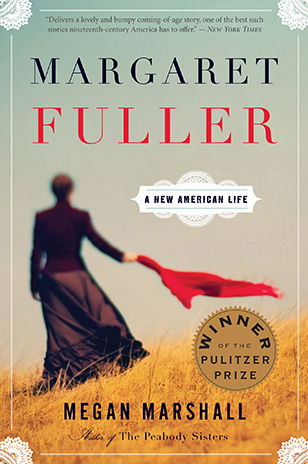 Megan Marshall’s much-awaited biography of Margaret Fuller is here!
Megan Marshall’s much-awaited biography of Margaret Fuller is here!
Advance reviewers have already praised Margaret Fuller: A New American Life as “a magnificent biography,” “spectacularly detailed” and written with a “unique intimacy.” Emerson’s biographer Robert D. Richardson writes, “this is the book Margaret Fuller would have wanted.”
Marshall tells the story of Fuller’s rise to prominence among the Transcendentalists, her vexed relationship with Ralph Waldo Emerson, the flowering of her feminism in New England and her departure for New York to write for Horace Greeley’s Tribune “at home and abroad,” leading to her love affair with Giovanni Ossoli—all with fresh insight and uncommon pathos. Synthesizing the scholarship of recent decades and drawing on her own research finds—a new record of Fuller’s famous Conversations for women, an Emerson letter describing Thoreau’s findings at the site of the fatal shipwreck, an engraving of Rome belonging to Fuller that survived the wreck—Marshall brings our great American heroine to new and vivid life. If you loved The Peabody Sisters, Marshall’s first award-winning biography, you will love Margaret Fuller.
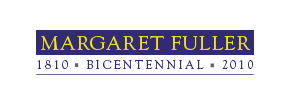
MARGARET FULLER BICENTENNIAL SERMON CONTEST Sponsored by the Unitarian Universalist Historical Society and the Margaret Fuller Bicentennial Committee A new one-time only award will be given in 2010 for the best sermon drawing on the life and work of Margaret Fuller. The sermon may feature her life story, her work, and/or her writings, as they apply to the concerns and issues of today. A $350 award for the best sermon will be given at General Assembly 2010. The sermon will be published on the Bicentennial website, www.margaretfuller.org. The goals of this contest are:
- To promote greater awareness of the importance of Margaret Fuller, Unitarian foremother
- To encourage congregations to celebrate Margaret Fuller Sunday at some time during year. Her 200th birthday is May 23, 2010.
- To develop ongoing resources for the continuing study of Margaret Fuller
- Include cover page, separate from the text, with name, address, phone number, email, date and location of sermon delivery.
- Submit in MS Word, Rich Text Format, or Plain Text to sermon@margaretfuller.org or mail to: Margaret Fuller Bicentennial, c/o Rainbow Solutions, 225 Arlington St, Medford, MA 02155
Subcategories
News
Select a news topic from the list below, then select a news article to read.

